CHAPTER TWELVE
AMERICA WANDERS OFF COURSE
BUSH Jr. AND 9/11
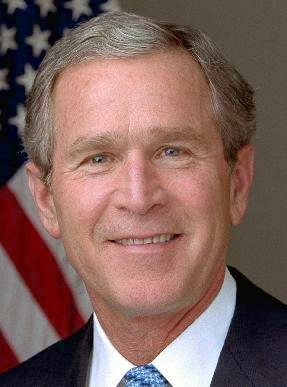 The making of George (“W”) Bush – or Bush Jr. The next American president, George W. Bush (son of the previous Bush president), was like Clinton a Boomer − except that his Boomer Idealism was not restrained by countering forces. Even his cabinet (or those on the cabinet closest to his own heart anyway) simply obliged him in his Idealism rather than offer him wise counsel. In part that was because of their own political ambitions − not particularly exceptional however in how politics works!
The making of George (“W”) Bush – or Bush Jr. The next American president, George W. Bush (son of the previous Bush president), was like Clinton a Boomer − except that his Boomer Idealism was not restrained by countering forces. Even his cabinet (or those on the cabinet closest to his own heart anyway) simply obliged him in his Idealism rather than offer him wise counsel. In part that was because of their own political ambitions − not particularly exceptional however in how politics works!
He started out life in his father’s Texas oil world, but went through his school years in New England, at Phillips Academy in Massachusetts and Yale University in Connecticut − although at the latter he like to stand out as a hard-drinking Texas good-old boy. But he subsequently (1968) went home to Texas, joined the Texas Air National Guard, returned to New England to get an MBA at Harvard’s business School (1973-1975), and returned to Texas to start up his own oil and gas exploration company. He married in 1977, ran unsuccessfully for Congress in 1978 … but prospered in his oil and gas business. This allowed him in 1989 to purchase the Texas Rangers baseball team, which when he sold his interests in the team nine years later made him a multimillionaire.

Bush (Jr.) with his wife Laura and daughters Jenna and Barbara – 1993
And along the way he became more evangelical in his Christian life, leading him in 1987 to be assigned liaison work with various evangelical ministries during his father’s early presidential campaigning.
In 1994 he ran as a Republican for the position as Texas governor, was strongly successful − with 53.5 percent against his Democrat opponent Ann Richards’ 45.9 percent of the vote. It was at this point that he identified himself as a “compassionate conservative,” working hard to cut taxes, improving educational standards for Texas minority youth – especially among the Hispanics (he loved to display his Spanish language skills!) – and in general doing all he could to support local Christian faith-based groups involved in social reform at the grass roots. This all proved so successful that in 1998 he was re-elected governor by not only a huge majority (69 percent) but as the first in Texas history to win a back-to-back electoral victory.
In 2000 he decided to run for the U.S. presidency, narrowly defeated the war-hero and highly-experienced Congressman John McCain for the Republican candidacy … then also narrowly defeated his Democrat opponent Al Gore (formerly Clinton’s Vice President).
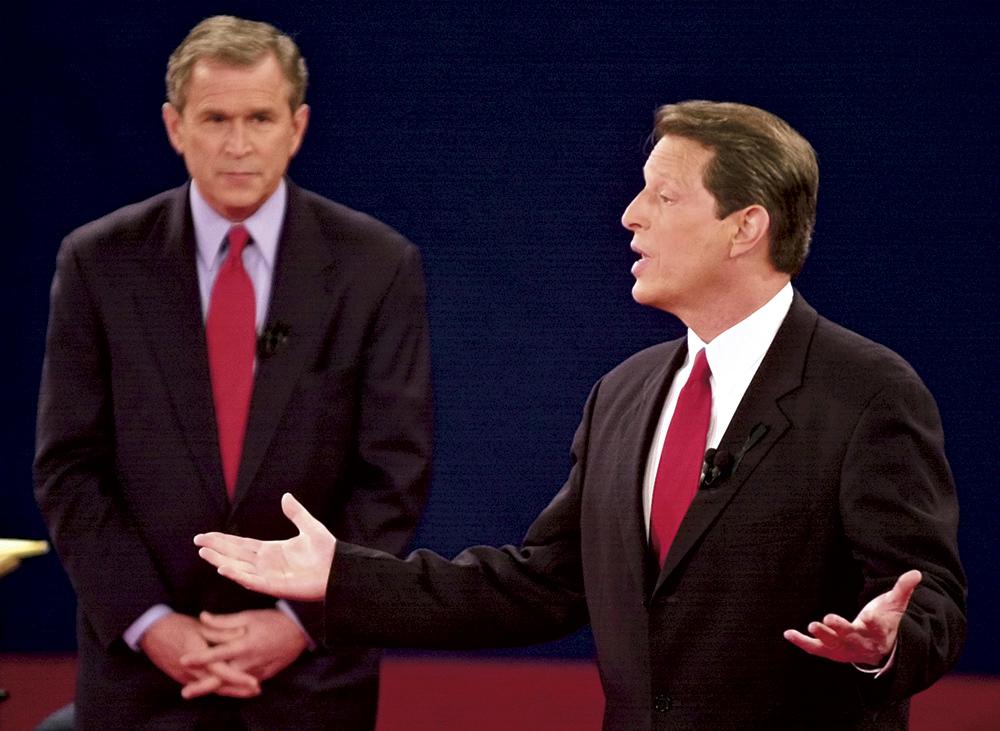
Bush and Gore debating – 2000
Actually Gore had outnumbered Bush in the national popular vote, 48.4 to Bush’s 47.9 percent. But ultimately the election came down to the Florida electoral vote. Finally, after a long legal contest reaching all the way to the Supreme Court, the Florida vote* was extended to Bush, giving him a 271 to 266 electoral win over Gore.
The tragedy of 9/11. Bush clearly approached the presidency the way he had the governorship, as the “compassionate conservative” putting great emphasis on his desire to see America upgraded culturally, especially among America’s minority groups. Thus he put a lot of weight behind his educational program, “No Child Left Behind.”
Thus that first year in office (1991) he was in Florida, conducting a well-publicized visit to a local school, when on the morning of September 11 (thus 9/11) he got the alarming news that one, then a second, airplane had flown into the New York Twin towers.

A third one also hit a part of the Pentagon Building in D.C. Soon a fourth plane went down, because at this point the passengers had heard the news of the other accidents, and seeing themselves now headed for the same destruction at the hands of Arabs who had taken control of their aircraft, were able to bring it down in the Pennsylvania woodlands before it could reach its destination (probably the White House or the Capitol Building).
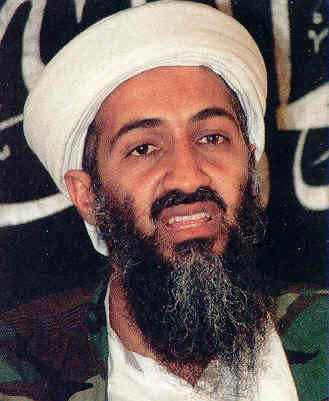 Americans were shocked. But so was the Western world (although parts of the Arab world were quite delighted). But there was little at this point that could be done, the guilty Arabs themselves dying in the venture – and their likely commander, Osama bin Laden, hiding somewhere in the remote areas of Afghanistan. Furthermore, the Afghan government, under militant Taliban control, was most unwilling to give up bin Laden to Western authorities.
Americans were shocked. But so was the Western world (although parts of the Arab world were quite delighted). But there was little at this point that could be done, the guilty Arabs themselves dying in the venture – and their likely commander, Osama bin Laden, hiding somewhere in the remote areas of Afghanistan. Furthermore, the Afghan government, under militant Taliban control, was most unwilling to give up bin Laden to Western authorities.
The catastrophic “Bush Doctrine”
The Afghan war. Thus it was that the Bush Administration found itself heavily focused on bringing bin Laden to justice, even if that meant having to invade Afghanistan to do so. CIA director George Tenet was most willing to use inside sources to try to track down and take out bin Laden in Afghanistan. But Bush seemed deeply won over to the idea that it was now his duty not just merely take down the al Qaeda organization behind this terrible Muslim plot, but to take down any regime (thus Afghanistan’s Taliban regime) supporting such terrorism, and replace that regime with a new democratic political system – something that would come to be termed the “Bush Doctrine.”
Wow! Take down the militant Taliban governing Afghanistan. This was not going to be an easy matter, as the failure of the Soviets a decade earlier to plant their own regime in Afghanistan proved quite clearly. And Bush either was unaware of – or chose to ignore – how Muslim culture’s political soil would not likely allow Bush’s democratic dream to grow in that environment by simply “freeing it up” from its present political system.
But anyway, his Secretary of Defense Donald Rumsfeld was most anxious to try out his new war machine, his highly “professional” U.S. Army. And his closest advisor, Vice President Dick Cheney, stood strongly with Rumsfeld on this matter. Thus Tenet was told to stand down. This was going to become a military matter, not a CIA operation.
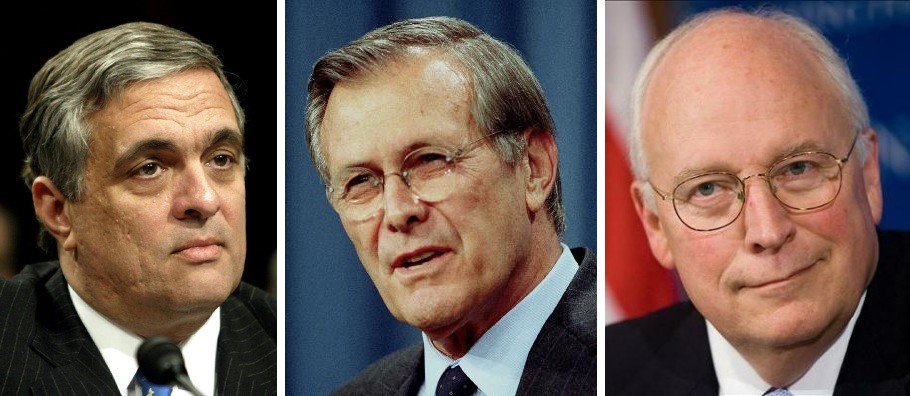
Tenet Rumsfeld Cheney
Of course the military was hardly ready to respond quickly to the al Qaeda/Taliban challenge, allowing bin Laden plenty of time to go into hiding, even retreat into Pakistan, a supposed American ally, that had also made it clear that it was in no mood to surrender al Qaeda or its training camps (and headquarters) based in their country. And Pakistan being a nuclear-armed country, Rumsfeld was obviously not in a position to challenge Pakistan on this matter. Thus the “Bush Doctrine” did not apply to the one country actually protecting bin Laden.
So ultimately, all of this really had nothing to do with bringing al Qaeda to justice. It was about … well, what exactly? But as a result of 9/11, America began to gear up for a war that had many of the same features as America’s involvement in Vietnam. Thank you, Mr. President.
Somewhat surprisingly, other countries – NATO partners Great Britain, Germany, Canada, and Italy plus Australia and New Zealand – agreed to send some of their own troops to assist the American military, perhaps in part because they themselves had lost citizens of their own in the collapse of the Twin Towers. In any case, American military operations in Afghanistan began that November … and would take three years to drive the Taliban from major portions of the country and put a pro-Western government in place in Kabul under Hamid Karzai.
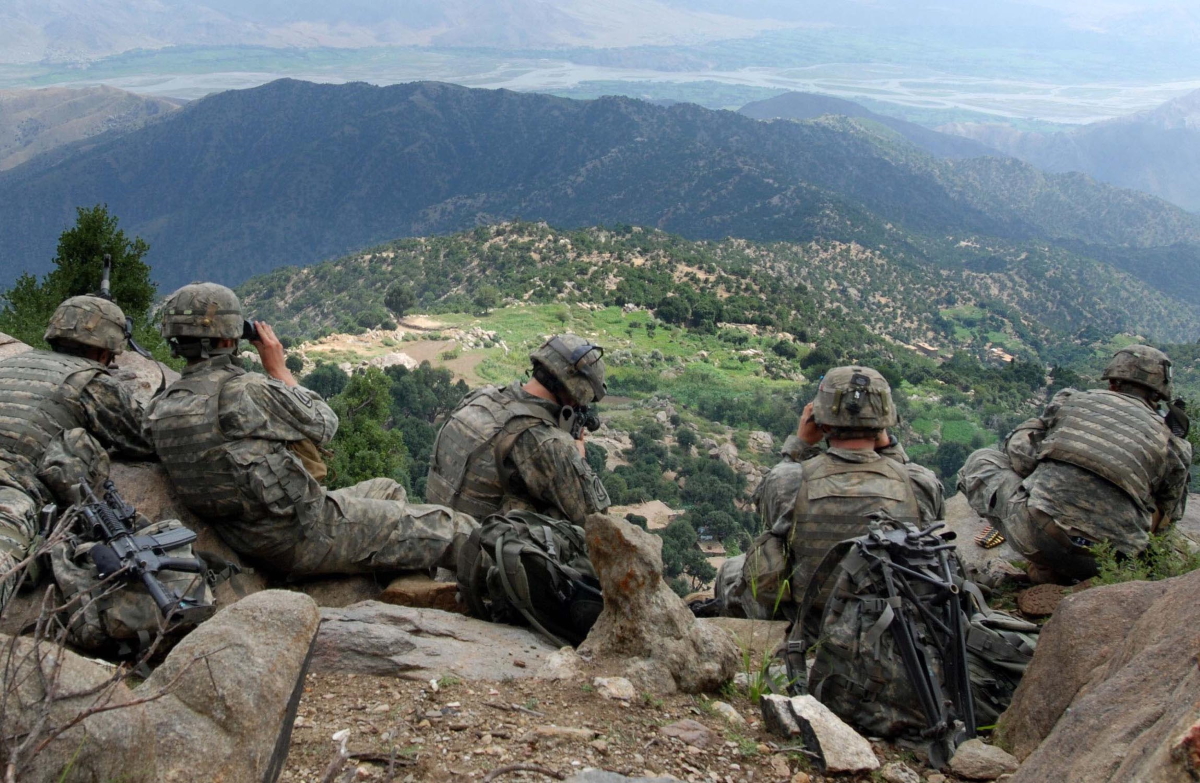
U.S. Scouts overwatch 2nd Platoon operations in a village below – 2006
But the Taliban was not interested in quitting, and began a counter offensive, in which by 2007 they had taken back much of their lost territory. This in turn required a large Western counteroffensive, which, under Bush’s presidential successor Barack Obama, regained much of that same territory by 2011.
And thus the war that cost much and gained very little (bin Laden’s al Qaeda remained untouched) dragged on past the Bush Administration and well into the following Obama Administration. And even then, it was a secret operation, not Rumsfeld’s military program, that finally brought bin Laden down. But more about that later.
Iraq. It’s hard to explain Bush’s interest in Iraq. Iraq had nothing to do with 9/11. It was simply that Bush seemingly wanted to do the job his father had failed to do − take down Iraq’s dictator, Saddam Hussein. In line with his Bush Doctrine in Afghanistan, Bush let the world know that he was deeply committed to bringing democracy to Iraq. But how, and why? Iraq was a multicultural society, Sunni Kurds, Sunni Arabs and Shi’ite Arabs disliking each other intensely, and thus held together largely through the dictatorship of Saddam and his Baathist political organization. Vice President Cheney knew full well that such an enterprise was to fall into the “quagmire” of Iraq. So why was he now standing with Bush Jr. on this matter? Was this simply a matter of personal political opportunism − as Bush’s closest advisor? Several key members of Bush’s cabinet, his Secretary of State, the highly militarily experienced Colin Powell, his National Security Advisor Condoleezza Rice, and CIA director Tenet were not at all convinced that this was a good idea.
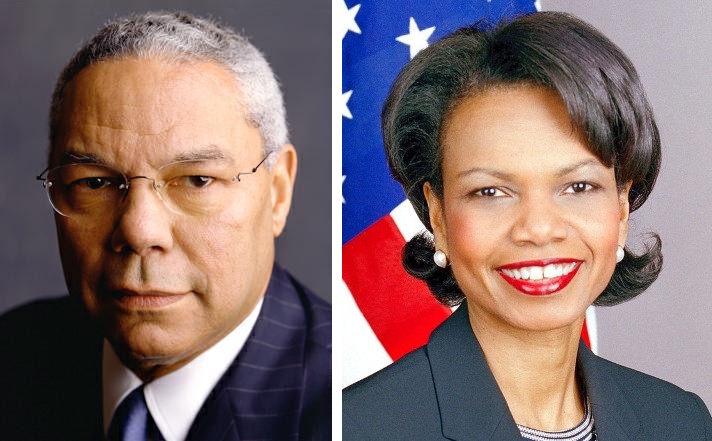
Powell Rice
And for that matter, neither was the rest of the world. Bush tried hard to sell the idea that Saddam was developing nuclear weapons of mass destruction (WMDs) in violation of various U.N. resolutions. Thus in September of 2002 Bush went before the U.N. to plead his case, clearly not convincing even his NATO allies (except Britain which agreed to support him … should he get U.N. approval). Most disappointingly, all he could get was for the U.N. to agree to increase U.N. inspections.
Tragically, he did get Congress in November to approve his use of military force against Iraq,* despite the fact that Tenet could offer Congress no actual evidence of WMD buildup in Iraq, only rumors about nuclear materials being sold to Saddam by the African country Niger.* And even here, this was all merely speculation, hardly a reason to send a country to war.
But Bush was still hoping for world support, and in February of 2003 sent his highly respected Secretary of State Powell to the U.N., offering pictures and documents in support of the American position that WMDs were developing in Iraq, as well as a number of training camps for al Qaeda.
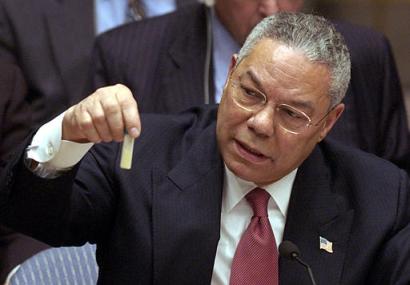
Powell with an anthrax vial … trying to persuade the U.N. of Iraqi WMD dangers – February 2003
But he was unable to convince Russia, China, France or Germany of the authenticity of these claims, and indeed merely inspired a huge global protest of fired up protesters against the American position.*
Finally, a frustrated Bush simply announced the following month (March) that Saddam had 48 hours to give himself up … and then unleashed Rumsfeld’s “Shock and Awe” bombing on Baghdad when Saddam did not meet the deadline.

“Shock and Awe” conducted by “pro-democracy” American bombers over Baghdad – March 2003
Somehow Bush was expecting the Iraqis to rise up and join him in “Operation Iraqi Freedom” and accept their new “democratic” leader Ahmed Chalabi, whom Rumsfeld had put forward, believing Chalabi had widespread support in Iraq. Weren’t Bush and Rumsfeld surprised to soon discover that Iraq’s knew nothing of Chalabi.
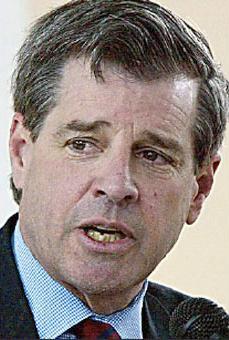 Then to make the situation even worse, a Rumsfeld appointee, Jerry Bremmer, was sent in May to Iraq to take command of the situation. Immediately he issued an order that any former member of the Baathist Party would be ineligible for professional service in the “new Iraq.” This was a disastrous move, as Baathist membership was an absolute necessity for every medical, scientific, educational and governmental professional in the country, quite irrespective of any particular political views they might hold. Thus Bremer was bleeding Iraq of its leadership talent – with nothing in particular to replace it.
Then to make the situation even worse, a Rumsfeld appointee, Jerry Bremmer, was sent in May to Iraq to take command of the situation. Immediately he issued an order that any former member of the Baathist Party would be ineligible for professional service in the “new Iraq.” This was a disastrous move, as Baathist membership was an absolute necessity for every medical, scientific, educational and governmental professional in the country, quite irrespective of any particular political views they might hold. Thus Bremer was bleeding Iraq of its leadership talent – with nothing in particular to replace it.
Then a week later he gave a second disastrous order, namely that Iraqi soldiers – who had been working with the American military to try to enforce some degree of order – had to surrender their arms. In this all he achieved was to make bitter (and experienced) Iraqi soldiers into American enemies. At this point serious military opposition broke out against the American occupiers.
Whatever it was that Rumsfeld (and Bush and Cheney) assumed was to develop in Iraq was never going to happen … despite Bush flying to American aircraft carrier Abraham Lincoln (actually docked in California) to celebrate “Mission Accomplished.”
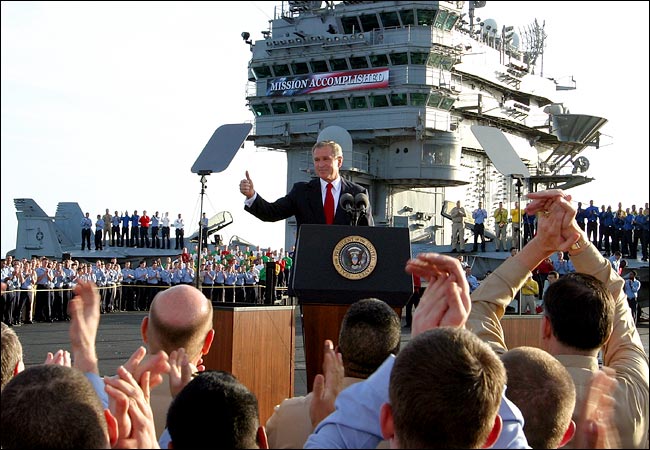
“Mission Accomplished” – May 2003
But ironically, the only thing that was “accomplished” was that Bush had thrown America into another war, very expensive in terms of lives and lands destroyed – with nothing much resulting except for America to find itself caught up in a war that would last through the Bush presidency.
Political repercussions at home. Most surprisingly, Bush was re-elected to the presidency in the 2004 race, largely because the contest was fought over personal rather than policy matters. Bush’s Democrat opponent Kerry had his military service record challenged (actually most unfairly) by a group of Vietnam veterans.
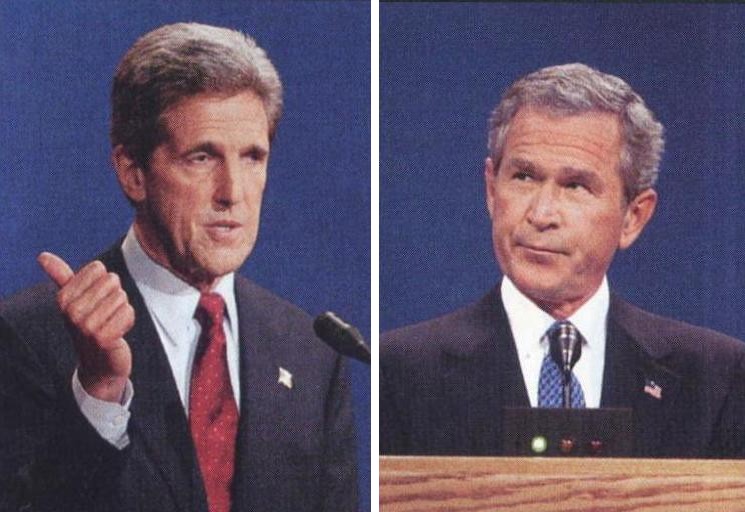
Kerry and Bush in their first televised debate – 2004
And a CBS report designed to cripple Bush had to be repented of publicly when it was revealed that reporter Dan Rather had been using false information – producing rather sympathetic support of Bush in the process.
But things did not go well for the Republican Party in the 2006 congressional elections, the Republicans losing their majority in the House and having their position in the Senate reduced. Sadly it was only then that Bush got rid of his largest liability, Rumsfeld* – with Republicans complaining that he should have done this before the elections.
The 2007 “troop surge” in Iraq. With Rumsfeld gone, Bush was able to move from Rumsfeld’s ineffective “small footprint” strategy and, under other military advice, direct a massive increase in number and movement of American troops in Iraq, finally impressing Iraqis enough to be more cooperative – and allowing the British to finally retreat from Iraq. And with the Iraqi military now in better command of the situation, the withdrawal of American troops could begin.
Where all this left Iraq – and the Middle East. In the end, all that this “democratizing” of Iraq accomplished was to take power away from Iraq’s Sunni Muslims and put that power in the hands of their bitter enemies, Iraq’s Shi’ite Muslims. This not only embittered the Sunnis deeply – not only in Iraq but also across the larger Sunni Arab world – it led eventually to the creation of a new Sunni Muslim caliphate (the Islamic State or ISIS), dedicated to undercutting the American (and Western) cultural-political position in the Middle East as much as possible.
As for the Shi’ite Iraqis, they found that they were now happy to be operating as part of the world led by neighboring Shi’ite Iran – the latter a dedicated enemy of America. Thus Iraqi Shi’ite “gratitude” to America for having bought them to power was mixed – very mixed.
And what did America get out of this very costly venture? Apparently nothing.
America’s 2008 economic catastrophe
Also as part of his legacy, as Bush was coming to complete his second term (2008), he left his Republicans in terrible shape politically, although not just because of the war but because of a grand economic catastrophe that had just hit the nation. A number of factors were involved, mostly resulting from various decisions to “improve” the economy by setting aside traditional economic logic.
One of these was the huge government debt, a debt that doubled from $5 trillion to $10 trillion during Bush’s 8-year presidency. The Afghan-Iraqi wars were big contributors to those figures. But so was also the decision of the Federal Reserve to lower its interest rates − normally running at around 5% to 6% − to the astounding rate of 1%.

Former Federal Reserve chairman Alan Greenspan …
and his replacement Ben Bernanke – 2005
This not only gave the government a good excuse to run up its debt (making that debt less costly to maintain − and even expand considerably), it had the same impact on private America as well. Home mortgages and car loans now could run at astonishingly low rates − allowing citizens as well as their government to run up huge debts. And banks were excited to get into this dynamic, extending “subprime” mortgages to house purchasers who under normal circumstances would never qualify for such loans.
This in turn brought a huge surge in the home construction industry, as builders jumped into the game of building and selling new homes. But they weren’t watching closely to notice how the supply now (by 2007) exceeded greatly actual demand (again: “market saturation”). At this point, sellers − as well as just people wanting to move on in life − found they had to drop their asking prices for these homes … gradually even lower and lower to get any results.

Now panic set in as banks found their customers simply abandoning their mortgages as those mortgages exceeded the sales value of those homes. Banks now faced bankruptcy … even many of America’s major banking corporations. By 2008 such Wall Street firms as Bear Sterns, Lehman Brothers, Merrill Lynch, Washington Mutual, etc. found themselves facing bankruptcy. And the huge lending companies, the Federal National Mortgage Association (“Fannie Mae”) and Federal Home Loan Mortgage Corporation (“Freddie Mac”) were saved only by $100 billion in government support.
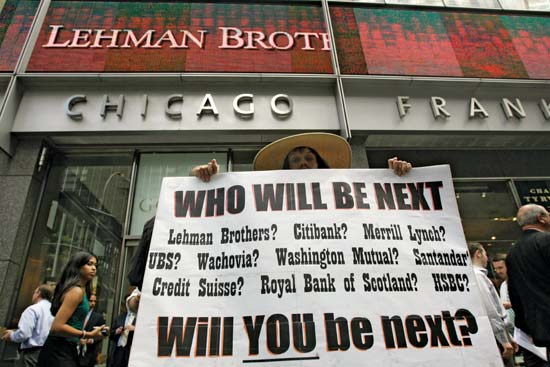
Finally (late September of 2008, close to election time), Bush decided to step in to save the companies that had not already collapsed, getting Congress to pass (very reluctantly) a $700 billion Troubled Assets Relief Program (TARP), lending money to such companies. And by this time such assistance was needed even by the Detroit “Big Three” automobile manufacturers (Ford, General Motors and Chrysler), themselves facing bankruptcy.
This was indeed the worst financial catastrophe the nation had experienced since the onset of the Great Depression back in the 1930s. And national elections were coming up. And quite naturally, the party in power would take a huge hit delivered by a very upset citizenry.
The Federal courts expand their Secular cultural program
In the meantime, the Federal courts were very busy promoting their crusade to “Secularize” America. Two particular cases are most noteworthy.
The first case involved the very Liberal 9th Circuit Court (the West Coast and Hawaii) in which in 2000 Michael Newdow sued Congress over the part of the Pledge of Allegiance which includes the word “under God,” claiming that this was harmful to his daughter. The 9th Court was supportive of Newdow – but the Supreme Court in 2004 reversed the situation … but only because he did not have custody over his daughter. The 9th Court then granted him such custody, prompting the opposition to him − and the Freedom from Religion Foundation backing him − by the pro-Christian Becket Fund. This ultimately backed down the 9th Court. But Newdow then went from court to court (thankfully unsuccessfully), challenging not only the pledge but also the use of prayer and the wording of the oath of office at presidential inaugurations.
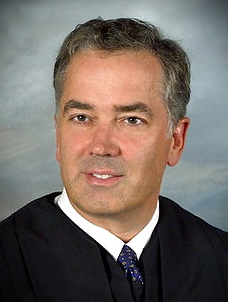 A more serious matter occurred in the 2005 Kitzmiller v. Dover Area School District case, in which Middle-Pennsylvania District Court Judge John Jones sided with parents (supported by the ACLU) opposed to a brief statement to be read to 9th grade biology class students. The statement suggested that students should consider (on their own) looking into the way that the traditional doctrine of Intelligent Design (ID) had its own scientific backing – despite the embrace of Darwinism by most of modern science. Judge Jones sided with the plaintiffs in citing how this simple statement violated the 1987 Edwards v. Aguillard Supreme Court decision outlawing the doctrine “creationism” in public schooling. And to make his point – as a lesson to anyone ever wanting to attempt again such “breathtaking inanity” as those defending creationism had just done – he issued a $1 million fine against the school board (supposedly being generous because he did not hit the school board with a $2 million fine).
A more serious matter occurred in the 2005 Kitzmiller v. Dover Area School District case, in which Middle-Pennsylvania District Court Judge John Jones sided with parents (supported by the ACLU) opposed to a brief statement to be read to 9th grade biology class students. The statement suggested that students should consider (on their own) looking into the way that the traditional doctrine of Intelligent Design (ID) had its own scientific backing – despite the embrace of Darwinism by most of modern science. Judge Jones sided with the plaintiffs in citing how this simple statement violated the 1987 Edwards v. Aguillard Supreme Court decision outlawing the doctrine “creationism” in public schooling. And to make his point – as a lesson to anyone ever wanting to attempt again such “breathtaking inanity” as those defending creationism had just done – he issued a $1 million fine against the school board (supposedly being generous because he did not hit the school board with a $2 million fine).
And so things went with the Federal Courts.
OBAMA “CHANGES” AMERICA
The 2008 election
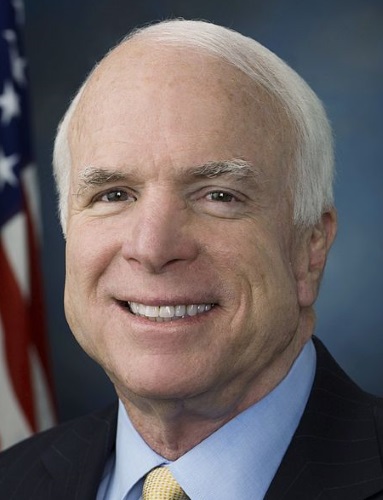 The Republicans that electoral year were running John McCain as presidential candidate. The Democrats largely avoided attacking McCain, so deeply respected was he as a Vietnam war hero (who had spent six years in a North Vietnamese prison camp, refusing to denounce his country, even though he was promised freedom if he did so) as well as an experienced Congressman and Senator (26 years in Congress).
The Republicans that electoral year were running John McCain as presidential candidate. The Democrats largely avoided attacking McCain, so deeply respected was he as a Vietnam war hero (who had spent six years in a North Vietnamese prison camp, refusing to denounce his country, even though he was promised freedom if he did so) as well as an experienced Congressman and Senator (26 years in Congress).
 They aimed their attacks on his running mate, Sarah Palin, claiming that she was merely a beauty queen bimbo (actually a quite capable Alaska governor) and dangerously close to becoming president because McCain was so “old” at 78. But the Democrats did not have much else by which to attack their Republican adversaries.
They aimed their attacks on his running mate, Sarah Palin, claiming that she was merely a beauty queen bimbo (actually a quite capable Alaska governor) and dangerously close to becoming president because McCain was so “old” at 78. But the Democrats did not have much else by which to attack their Republican adversaries.
But that really did not matter, because the Bush Administration had left the country in such bad shape that the Republicans were going to receive a bad hit from the American voters no matter what.
Anyway, the race was not really about principles or policies, but about personalities – under constant discussion by the nation’s “news” networks as way of keeping viewers focused on their unending 24/7 broadcasting. And what these news “commentators” had to say about things would shape opinions greatly, especially as their Gen-X audience took on greater importance in American society – Gen-Xers (offspring of the Boomer generation) known to be a generation of no particular principles, except to make the best of what was in their immediate self-interest … and engaging widely in games and entertainment to fight off social boredom.
And thus most significantly, the Democrats had just chosen such a Gen-Xer to be their presidential candidate, Barack Obama.
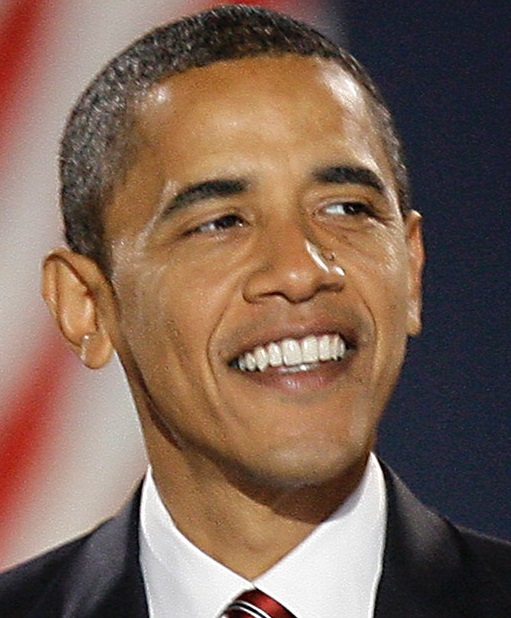 Barack Obama. Obama was born in Hawaii to two students studying there, a White mother and Black African father – the two separating soon after his birth. He would thus grow up without the discipline or support of a father. His mother would then marry a Muslim Indonesian student, and Obama and his mother would follow her husband to Indonesia when Obama was six. Obama’s experience there was quite varied, studying first at a Catholic school, then a Muslim public school. When he was ten, he was sent back to Hawaii to live with his mother’s parents – and then was joined the next year by his mother in order for her to finish her doctoral studies. He then received a scholarship (and financial support from his grandmother) to study at the prestigious Punahou School – and remain there residentially, even after his mother returned four years later to Indonesia.
Barack Obama. Obama was born in Hawaii to two students studying there, a White mother and Black African father – the two separating soon after his birth. He would thus grow up without the discipline or support of a father. His mother would then marry a Muslim Indonesian student, and Obama and his mother would follow her husband to Indonesia when Obama was six. Obama’s experience there was quite varied, studying first at a Catholic school, then a Muslim public school. When he was ten, he was sent back to Hawaii to live with his mother’s parents – and then was joined the next year by his mother in order for her to finish her doctoral studies. He then received a scholarship (and financial support from his grandmother) to study at the prestigious Punahou School – and remain there residentially, even after his mother returned four years later to Indonesia.
He would come to idolize the African father he never really knew, at this point exchanging his name “Barry” for his father’s more African-sounding name “Barack.” Indeed, even though he grew up quite successfully in a largely White world (actually rather racially mixed, as Hawaii happened to be), he would choose not to identify with that White world. Quite the contrary would be the case.
After graduating from Punahou in 1979, he went on to study at Occidental College in California, then two years later transfer to Columbia University in New York City. Most interestingly, he would find himself deeply involved in life in nearby Harlem, impacted deeply by the Christian message and music of a Black church located there. This seemed to confirm to him the idea that he was truly a “Black” and not just a multi-racial individual.
He then worked in the corporate world − ultimately in Chicago, to work with a Catholic Community-development organization operating in a Black neighborhood. He then took up law studies at Harvard … and returned to Chicago for summer internships − where he met and eventually (three years later) married Michelle Robinson. He eventually took up the law business specializing in civil rights, wrote an autobiography Dreams from My Father, and was elected to serve in the Illinois Senate (1996-2004). In 2002 he ran unsuccessfully for the U.S. House of Representatives – but had greater success in 2004 running for the U.S. Senate – the year the Republicans experienced their first hit under the Bush Administration. He also addressed the Democratic Party National Convention – bringing great attention to himself as a rising politician.
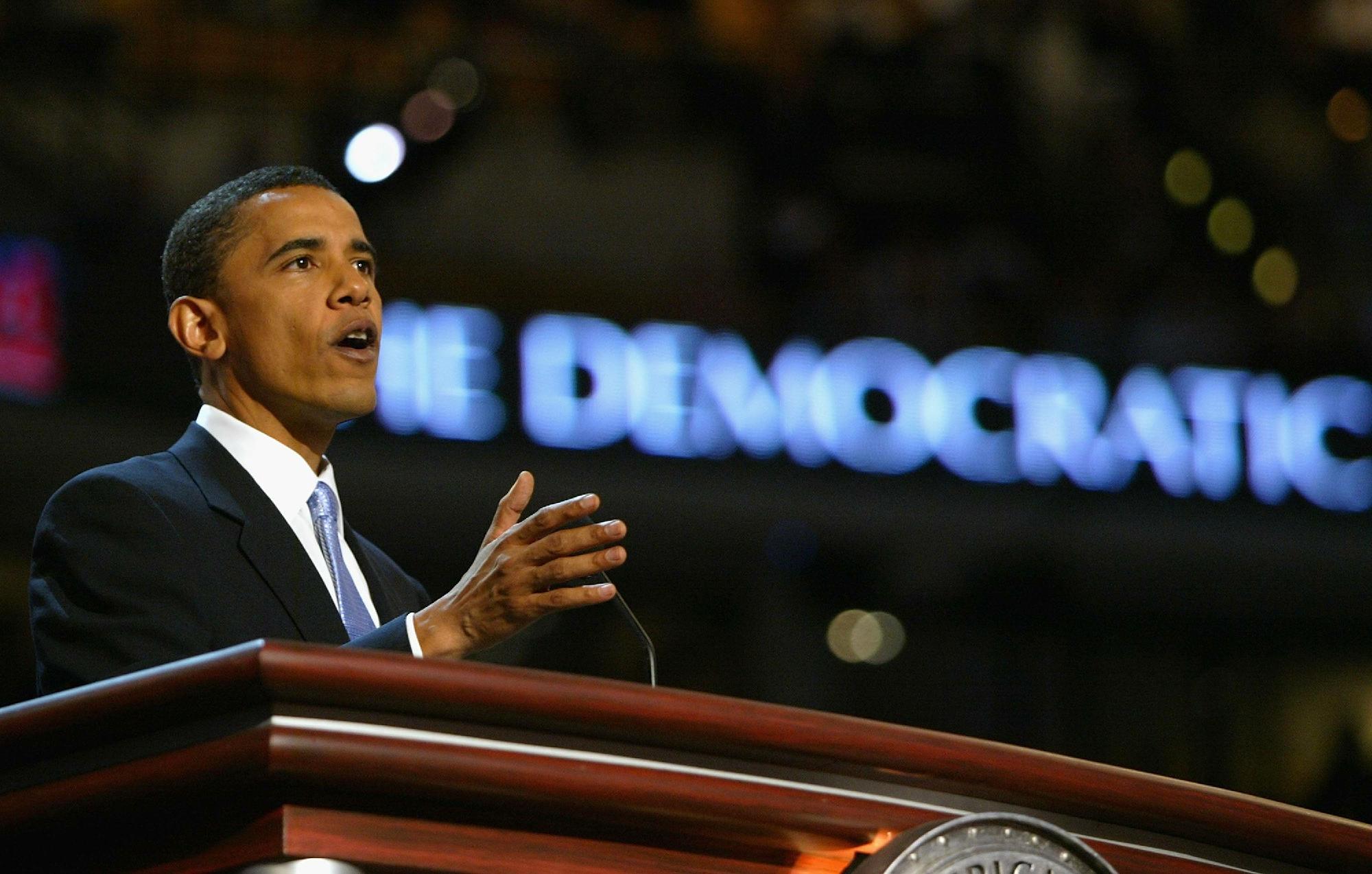
It would be two years later (2006) that the door to the U.S. presidency opened up when, in an interview with highly popular TV host Oprah Winfrey, she first challenged him to look into the idea. He would make a wonderful president. But on what basis? So far, his professional record was not particularly outstanding. He was however known as the furthest Left of the Left-wing Senators. This was something of note – though hardly the way to win a presidential race. But he was Black. And wouldn’t it be wonderful for America to finally have a Black president. Oprah soon interviewed him again, along with his wife, Michelle, offering again her endorsement of him as president (and a strong-willed Michelle as the U.S. First Lady). And about this time his second book, The Audacity of Hope came out, moving to #1 position of both the New York Times‘ and Amazon.com’s best-seller list. Then two more times (May and December of 2007) Oprah came out strongly in favor of Obama as president.
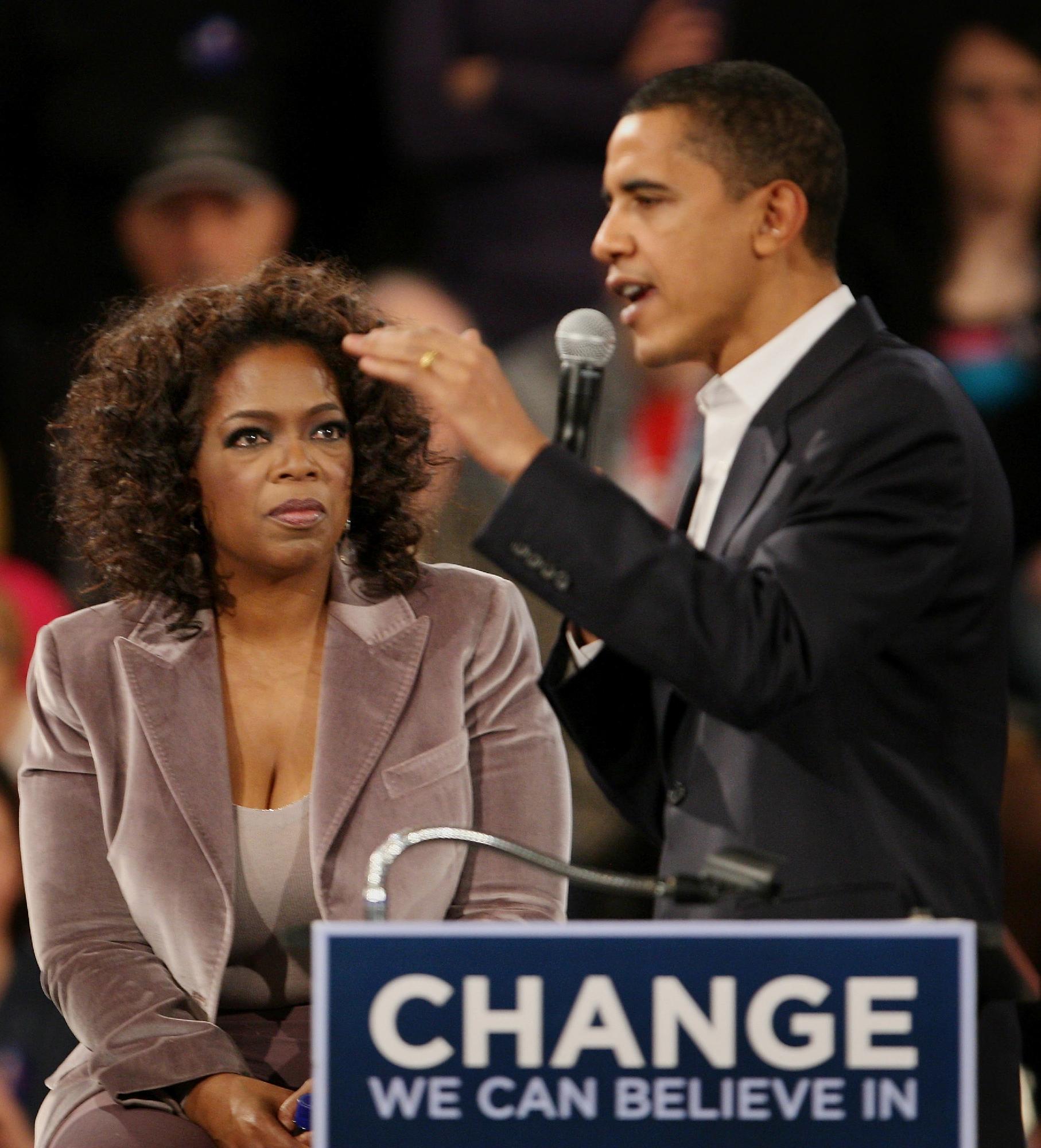
Oprah continuing to support Obama now that he is actually running for the presidency
Finally in February of 2008, Obama accepted the challenge. And by June of that year, Hillary had to drop out of the race for the Democratic Party nomination when it became quite clear that the nomination was going to go to Obama.
Ultimately, Obama put himself before the voting public as the candidate dedicated to “change” – deep change – in American politics. Certainly the mess that Bush left behind needed to be “changed.” But what did Obama’s “change” actually mean? In what areas, in what directions, and how deep was his realm of “change” likely to take the country? And would this strengthen the country in this time of confusion and weakness – or worsen the confusion and divide it even more deeply? But that was something that only time could answer. So Americans went to the polls to make the best they could of an American political mess confronting them.

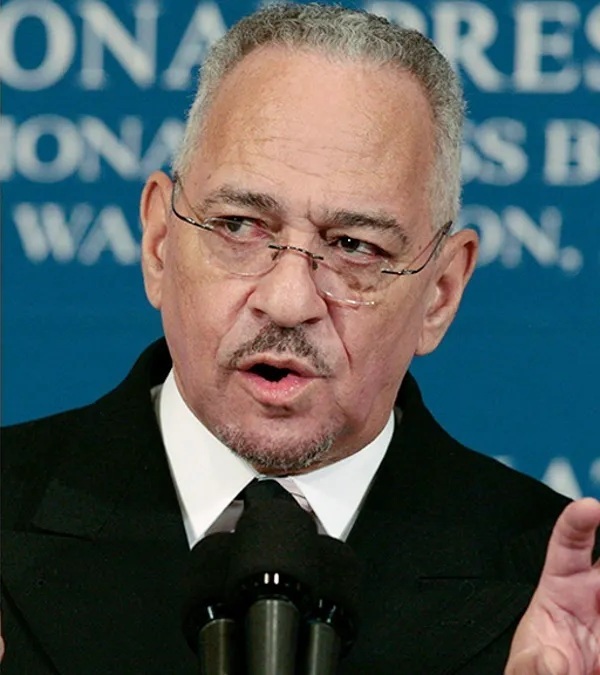 Obama the Christian
Obama the Christian
Besides his identity-affirming love of Harlem’s Black Christianity, Obama formed a particularly close relationship with Black Chicago pastor Jeremiah Wright, someone that came to have deep importance to him as some kind of missing father-figure. Over their 20-year time together, Wright officiated Barack and Michelle Obama’s wedding, performed their children’s baptisms, and inspired Obama’s book, The Audacity of Hope, by one of his sermons. But then Obama was quick to cut off that relationship when, during the election year, excerpts of some of Wright’s rather harsh anti-American and somewhat racist sermons and public interviews proved to be too much for the Obamas. Wright, who had been designated to perform the blessings at Obama’s inauguration should he be elected, was now cut off.
So where did that leave Obama as a Christian? Once in office, the Obamas would attend church here and there … but never really become part of any particular Christian community. And their social-moral ideals would stretch way beyond what Christians had long understood to be the kind of social thinking and action expected of a Christian.
The results of the 2008 election. Anyway, in the end, Obama scored a resounding victory, gaining 69.4 million votes (52.9 percent) to McCain’s 59.9 million votes (45.7 percent) and an Electoral College win of 365 votes to 173 votes. And in general, the Republicans took a huge beating, with the Democrats gaining 21 additional seats in the House, making their majority there 257 seats to the Republicans’ 178 seats. – and in the Senate, the Democrats gaining 8 seats for a total of 57 seats to the Republicans’ 41 seats (with 2 mostly-Democrat-supporting “Independents”). The Democrats thus had full control not only of the White House but also Congress. America was in for a ride of “change.”
Taking on economic challenges
The immediate problem facing Obama in taking office was the sad state of the American economy. Despite the huge growth in the government debt, more government spending was deemed necessary to bring the economy back to good order. Thus with the Republicans opposing but the Democrats fully supportive, $787 billion was appropriated for the country’s further economic recovery – which the program included, oddly enough, support for health care, education, green energy, and other social programs the Democrats were eager to see put in place.
And there was the matter of the American automobile industry, with the government taking 60 percent control of General Motors to bring the company back into operation after it became bankrupt (federal stock eventually to be sold off, but the original stockholders simply losing their investments in the company) and Chrysler having to be bought out by Fiat in order to rebuild that company after it too declared bankruptcy. And there was the decision to pay people to trade in their larger oil-consuming “clunker” vehicles for more energy-efficient vehicles, the government offering $2500 to $4500 as part of the trade-in depending on the vehicle’s size, the government having to have the program refunded when it quickly ran out of funds in the deal. But ultimately, the program benefited the Japanese and Korean auto manufacturers rather than Detroit. And the program actually produced a loss of $1.4 billion in car value in comparison to the supposed benefits of increased fuel efficiency.

Actually, over time, the TARP program enacted during Bush’s last days in office worked out quite well, as companies got back on their feet and were able to pay the government back for its loans to them. But economically, the benefits seemed to work best for the corporate executives, rather than the middle class and industrial workers – as top-level corporate salaries grew rapidly. And although these companies came back to strength, the American economy in general did not, growth being very slow over the next years – with unemployment remaining high (nearly 10 percent of the working age population in 2010) … many others (some 6 percent) employed only on a part-time basis.
With the very rich financial industry doing what it could to block Congressional efforts, Congress finally passed a greatly watered-down bill to put wild speculation (enormous in the world of financial “derivatives”) back under some degree of control after Bush had undercut the 1933 Glass-Steagall Act regulating the financial industry.
In the meantime, Washington continued its huge spending program, by August of 2011 having reached its legal debt limit or “ceiling” at around $14.5 trillion – putting the country in crisis as Democrats and Republicans fought over amending the law to raise the debt limit. Ultimately the Democrats won, raising that figure to $16.4 trillion … although it would quickly reach even that limit by the end of the following year (2012), just as Obama was finishing out his first term in office.
But the spending would never slow up, the debt ceiling raised in 2013, 2014, and 2015, the debt finally reaching the figure of $20 trillion by the end of 2016 – having doubled in size during Obama’s eight years as president.
“Obamacare”
Another early priority for Obama once in office was getting a dramatic overhaul of America’s healthcare system − so expensive that it was getting beyond many hard-working Americans’ ability to afford the insurance policies needed to cover outrageous medical costs. But the system was not only expensive, it was beyond anyone’s ability to understand. Indeed, to “remedy” this Byzantine healthcare system, the Obama proposal itself was 1017 pages in length − itself beyond the ability of anyone to understand. Congress tried to decide on the particulars of this complex bill … but ultimately only broad political loyalties (the Democratic majority in both houses against the smaller number of Republicans) was what decided the matter. But even there, the Republicans were able to detect a very suspicious national mood, forcing the Democrats to have to drop Obama’s “public option,” a government health insurance program which was designed to be cheaper than the private health insurance plans and which Obama said would thus force down the price of all insurance policies … but which the Republicans (and their wealthy friends in the medical insurance business) were able quite successfully to portray as simply “medical socialism.”
By the end of that first year (2009) the bill had passed only in the Senate (60-40) along party lines, and was losing support rapidly in the House. It finally passed in March of 2010 by a close vote of 219 to 212 − with all Republicans opposed in the House vote. So Obama’s program was in place, but achieved at a high political cost. So suspicious was the voting public of further government management of American life that the November elections that year brought a huge Democrat loss of six seats in the Senate (the Democrats still holding a small majority there) − but a massive overhaul of the House, the Republicans picking up 63 seats (the largest political swing since 1938) and thus a 242-193 majority in the House.
True − over time, Americans would come to be more supportive … taking five years before polls on the matter showed Americans as a whole finally being more supportive than opposed to the program.
“Diversity” rather than unity
But ultimately, what interested Obama the most was the undertaking of the promised “change” within America itself – the heart of the platform he ran on to win the presidency. And step by step he revealed that the “change” that would so deeply focus his presidency was to “broaden” the social-ethical base of American society. It was just too “White,” too “straight,” too “masculine” and – oddly enough despite his own supposed Christian faith-foundations – too “Biblically Christian” – indeed everything that it had been over the previous four centuries. It was time to “change” all that.
Making opposition to homosexuality a “hate crime.” In October of 2009, Obama signed the Hate Crimes Prevention Act − reversing official disapproval of the homosexual lifestyle to now disapproval of those still disapproving, that is, to those practicing what was now termed “homophobia.” And government job loss would be just the beginning of the punishment of those unable to switch their moral views to the new worldview Obama was promoting.
But when he tried to implement this in the U.S. military, he got considerable pushback … especially when the Republicans swept the House in the November 2010 elections − and he had just two months to work with a “lame-duck” Congress to push for homosexual support in the military before the strongly opposed Republicans would take office and block his efforts. So he got a soon-to-end Democratic Party majority to approve his bill, Obama getting his way before the voting public had their say.
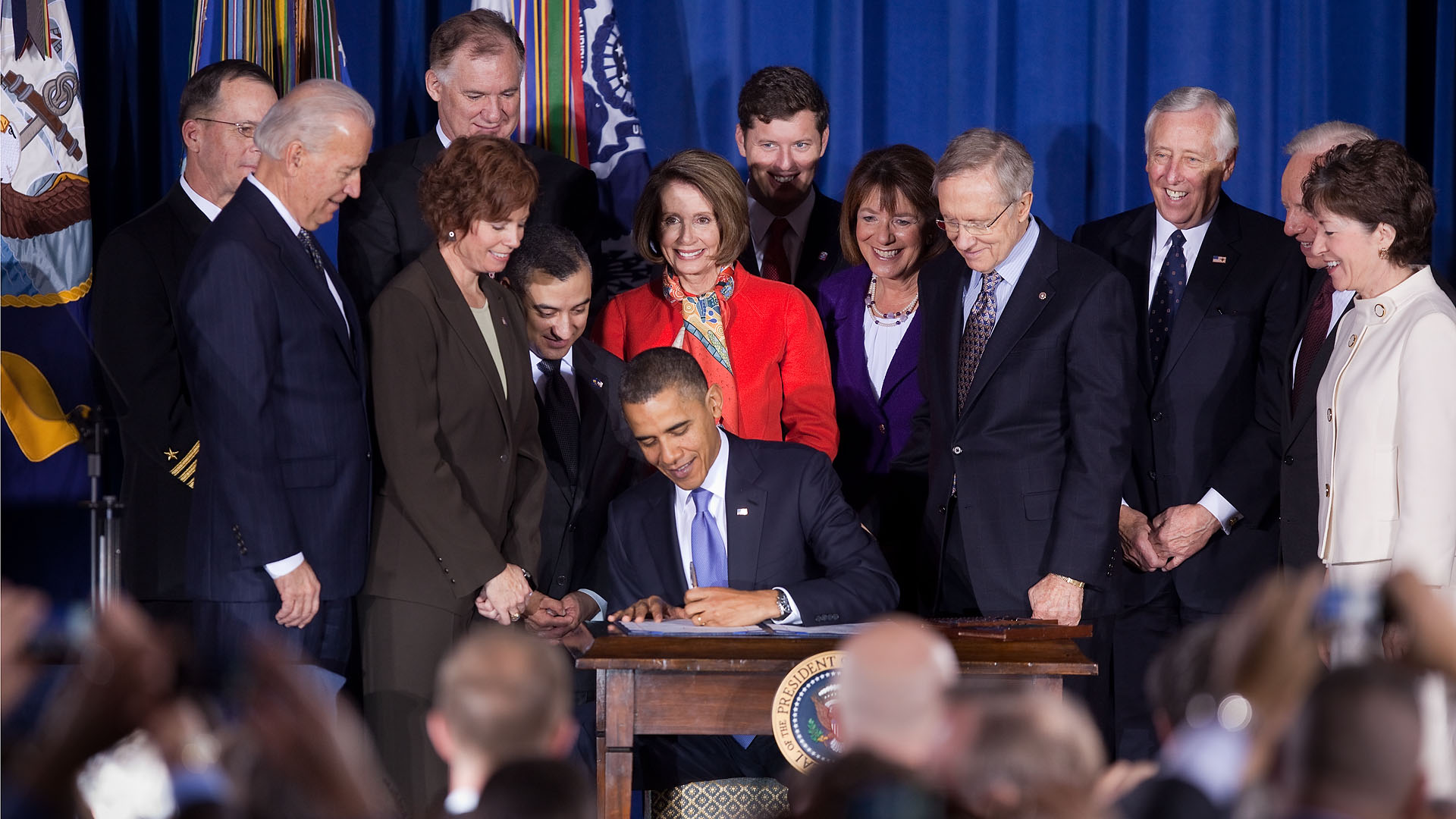
Obama’s Supreme Court appointments. In May of 2009, Obama was quick to nominate Sonia Sotomayor to replace retiring David Souter (a Liberal replacing a Liberal). Then the next year (May 2010) he nominated Elena Kagan to replace retiring John Paul Stevens – Stevens a bit of a political “centrist.”
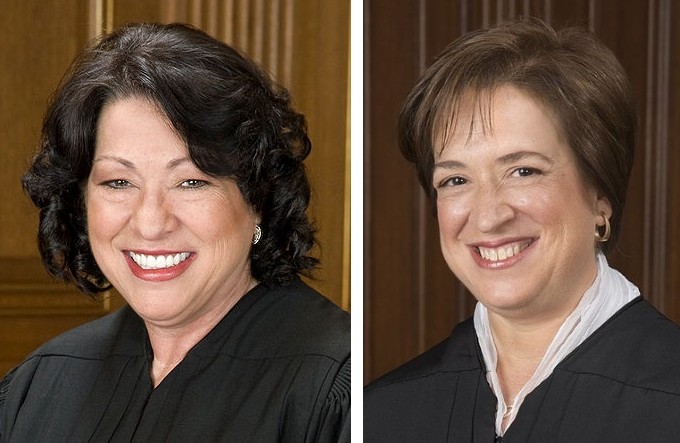
Sotomayor Kagan
What was most interesting about the appointments, other than that they were two females in exchange of two males, was that neither was married (Sotomayor previously divorced however) and both were childless. Sotomayor was rather defensively Hispanic in political culture and Kagan now brought Jewish membership of the Supreme Court to three of the nine. In short, Middle America was not represented in either of these two appointments. Needless to say, the Senate’s confirmation vote on these two Obama appointments followed closely its Democrat-Republican split.
The social ideal of traditional marriage taken down. With these Supreme Court appointments of Sotomayor and Kagan, it was merely a matter of time before the traditional idea of marriage itself was taken down. In two close 5-4 decisions, United States v. Windsor (June 2013) and Obergefell v. Hodges (June 2015) the reshaped Supreme Court declared one of Congress’s highly supported laws, the 1996 Defense of Marriage Act (DOMA) as “unconstitutional.” Thus it was that the Supreme Court made it official: DOMA was dead. Homosexual marriages were now to be recognized under law to be the same as male-female marriages.
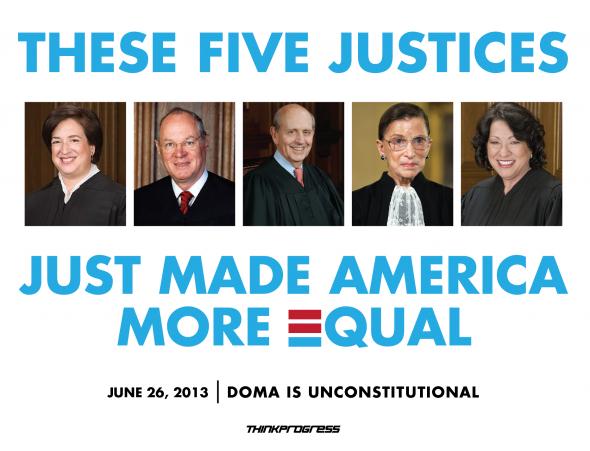
Now most clearly, but also most tragically for America (on a number of fronts) − this also certified the fact that the Supreme Court, not the American people’s representatives in Congress, was indeed America’s supreme or highest law-making authority … despite what the Constitution itself made quite clear. But in fact, the various decisions of the Supreme Court, not a two-centuries old document, was actually America’s “constitution” at this point.
Actually Obama got the ball rolling earlier on this matter of marriage when in 2011 he had his Attorney General Eric Holder announce to Congress that the Obama Administration would no longer enforce DOMA.
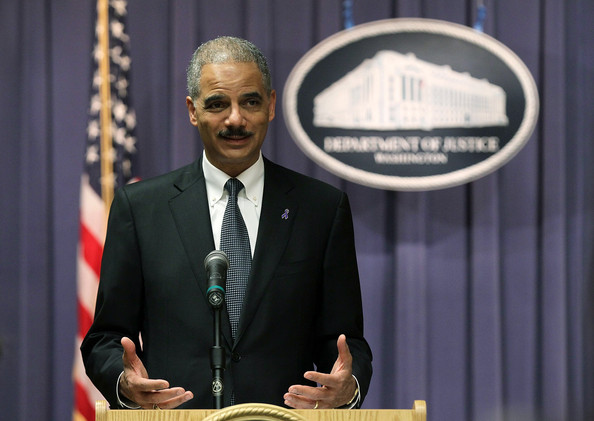
In this he had the backing of former president Clinton, who soon after the Supreme Court decisions announced that DOMA (which he had signed into law in 1996) was “incompatible with our Constitution.”
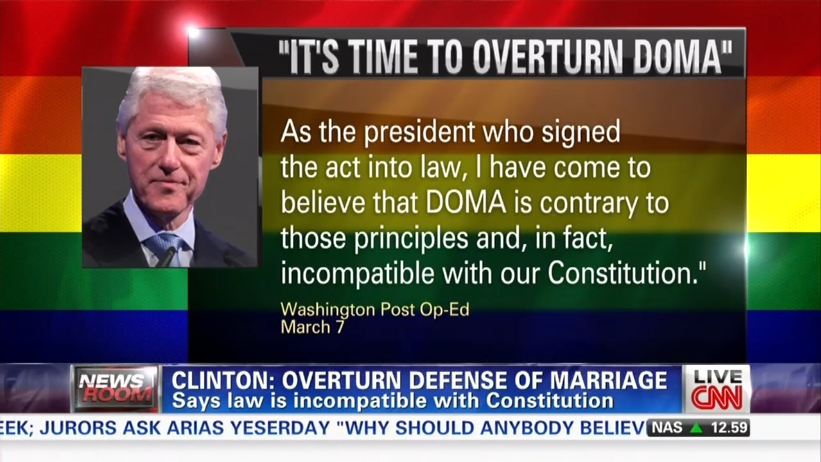
Wow … that didn’t take long for traditional marriage to move from Congress’s highly supported social institution to now a totally “unconstitutional” principle. Just 19 years of very deep “social progress!”
And it also did not take long for the pro-homosexual world to strike strongly against those still holding to those traditional sexual values. In 2015 an Oregon court imposed a $135,000 fine on a couple owning a bakery − who, because of their deep Christian beliefs, had simply informed a lesbian couple that they would have to look elsewhere for a wedding cake.

Aaron and Melissa Klein being punished for holding to their now-illegal Christian principles concerning marriage
The fine destroyed the bakery, invited protesters to harass their home, and dragged the couple through three more years of litigation, which ended in 2018 with the Oregon Supreme Court supporting the lower court’s decision and harsh sentence. And so things would now go in America.
Citizens United v. FEC (2010). But another horrible Supreme Court decision was made … but not because of Obama’s appointments. Sotomayor and Kagan would be part of the group opposing an earlier Supreme Court decision – a 2010 decision that basically opened the gates for big money to control America’s elections. This 5-4 decision overturned Congress’s 2002 Bipartisan Campaign Reform Act − for that matter, laws reaching all the way back to the presidency of Teddy Roosevelt − which placed restrictions on the size, type and timing of financial contributions allowed to be offered in the electoral campaign process.
Not only was Obama furious, also strongly opposed was his Republican opponent in the 2008 elections, John McCain − who also recognized that the Supreme Court had just taken the national vote out of the hands of ordinary Americans and put the results in the hands of the super-rich.
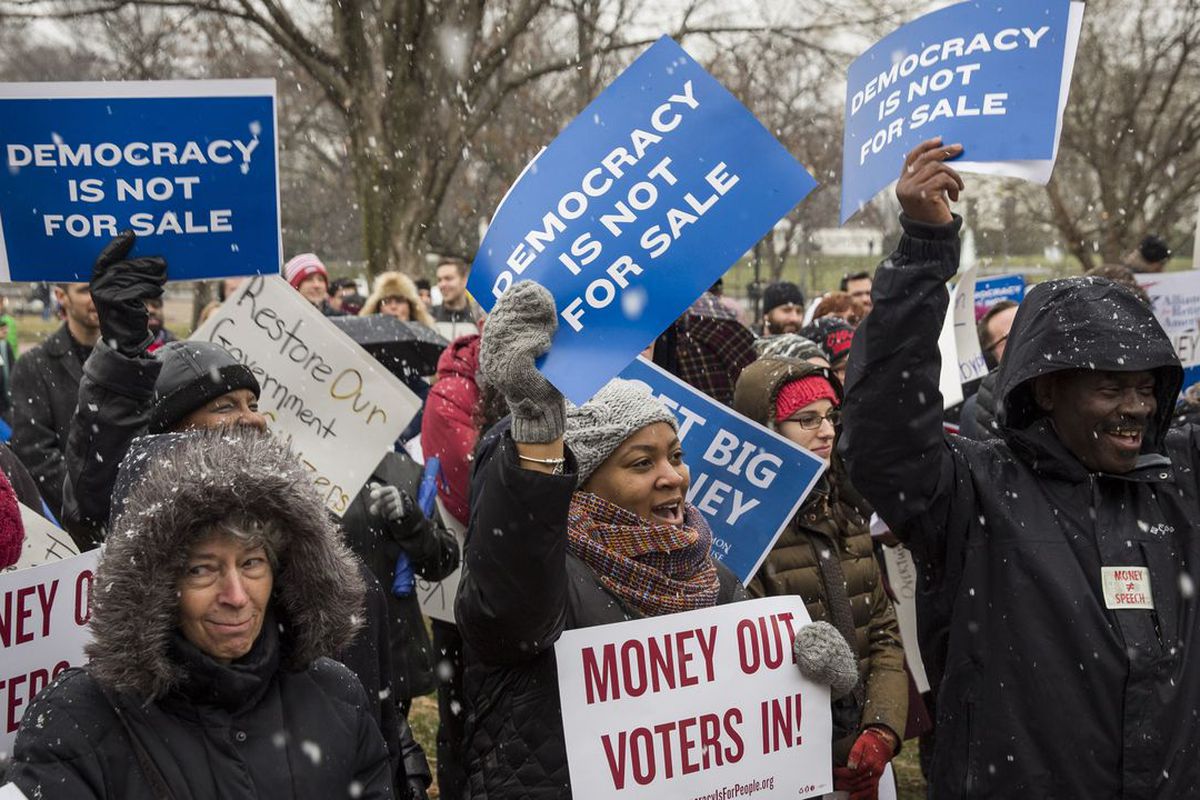
2015 – A protest (one of many over the years) in front of the Supreme Court building marking five years since the horrible Citizens United decision
Those Justices who supported the measure (Kennedy, Roberts, Scalia, and, in part, Thomas) claimed that they were simply recognizing the First Amendment’s “free speech” clause in ending government restriction. But that’s like making a sporting event “fairer” by removing the rules of the game and the enforcing referee − and expecting anything but chaos and bullying to result. What were they thinking? Societies need rules.
And although corporations were still restricted from making direct contributions to political campaigns, “Super PACs” (Political Action Committees) were soon set up to receive exactly those contributions − in favor of this or that candidate. Needless to say, huge campaign contributions make for a much louder voice in the ear of a public official than the voice of simply the voting public.
At first this was assumed to help the Republican Party (thus the way the decision went). But it did not take long for the Democrats to get into the game, and make it a powerful tool for themselves as well. In any case, this was a huge blow delivered against American democracy. Thank you, Citizens United!
Race relations worsen. There was no question that Blacks found themselves behind in the game of social significance. And for that, it was very easy to blame the Whites. Certainly Obama did.
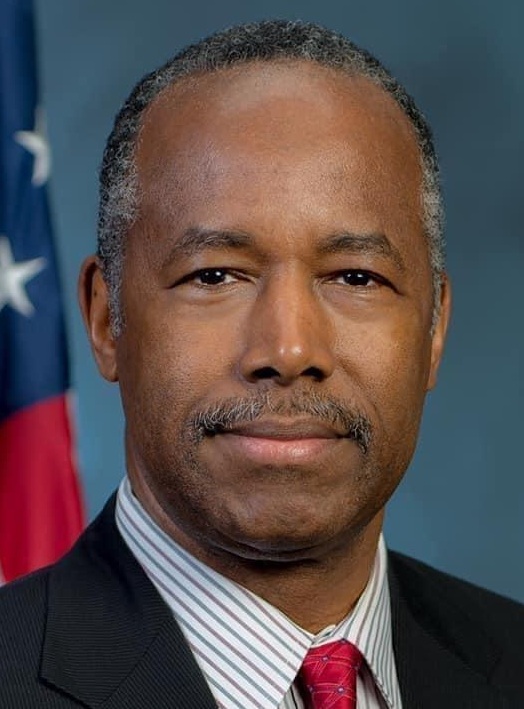 Not all Blacks did. Dr. Ben Carson, a world-renown surgeon, was most insistent that Blacks could and should work their way to such significance through their own efforts − the American way. As fully Black, he had done so … starting out life under a single mom, not doing well in school − until his mom convinced him that he could overcome all obstacles simply by dedicating himself to the task of self-improvement. And little by little, and then most awesomely, he rose even to social prominence.
Not all Blacks did. Dr. Ben Carson, a world-renown surgeon, was most insistent that Blacks could and should work their way to such significance through their own efforts − the American way. As fully Black, he had done so … starting out life under a single mom, not doing well in school − until his mom convinced him that he could overcome all obstacles simply by dedicating himself to the task of self-improvement. And little by little, and then most awesomely, he rose even to social prominence.
After all, wasn’t it the proven abilities of Black sportsmen and musicians that had brought them to prominence − even in a White world? Thus unsurprisingly, Dr. Carson − and a rising number of other Blacks who thought along lines similar to Carson’s − found a political home in the Republican Party, which stressed the importance of self-improvement … not the Democratic Party, which stressed protection by, and thus dependency on, government authority.
Obama was well aware of the problem facing the Black world. Even in 2008 (Father’s Day), in running for the presidency, he pointed out:
Children who grow up without a father are five times more likely to live in poverty and commit crime; nine times more likely to drop out of schools, and 20 times more likely to end up in prison. They are more likely to have behavioral problems, or run away from home or become teenage parents themselves. And the foundations of our community are weaker because of it.
And he had to be aware of a government report that came out in 2011, that murder was the No. 1 killer of Black males of the age 15-34 − around 40 percent of the deaths in that age range … compared to 3.8 percent for White males of that same age. But also, despite how Black militants like to depict things, the report also pointed out that more Whites than Blacks are killed by police, almost on a 2 to 1 ratio, although Whites make up five times the number of Blacks, so therefore the percentage figure for Blacks is higher. But it is important to note that the violent neighborhoods that patrolmen are expected to police bring them in confrontation with armed adversaries … so the killing rate would of course be much higher.
Tragically for America, despite his own bi-racial origins, and his upbringing by his White rather than his Black relatives, Obama had a hard time not directing his “change” against America’s White world. And of course, such attitudes would quickly bring things back to the way they were in the 1960s, when racial politics (which even Dr. King stepped away from) stirred not socially integrative, but instead racially vindictive Black Panther attitudes within the Black world.
A strong case in point occurred because of a confrontation between a Ferguson, Missouri, policeman, Darren Wilson, and a young Black, Michael Brown, in which a shooting resulted in the death of Brown. Over the next days, which included a visit from the “Reverend” Al Sharpton, Black protesting turned quickly into Black rioting, pillaging and burning, even across the country … and even before the facts in the case were clarified. Even White university students got in on the act, protesting against police brutality and demanding racial justice.
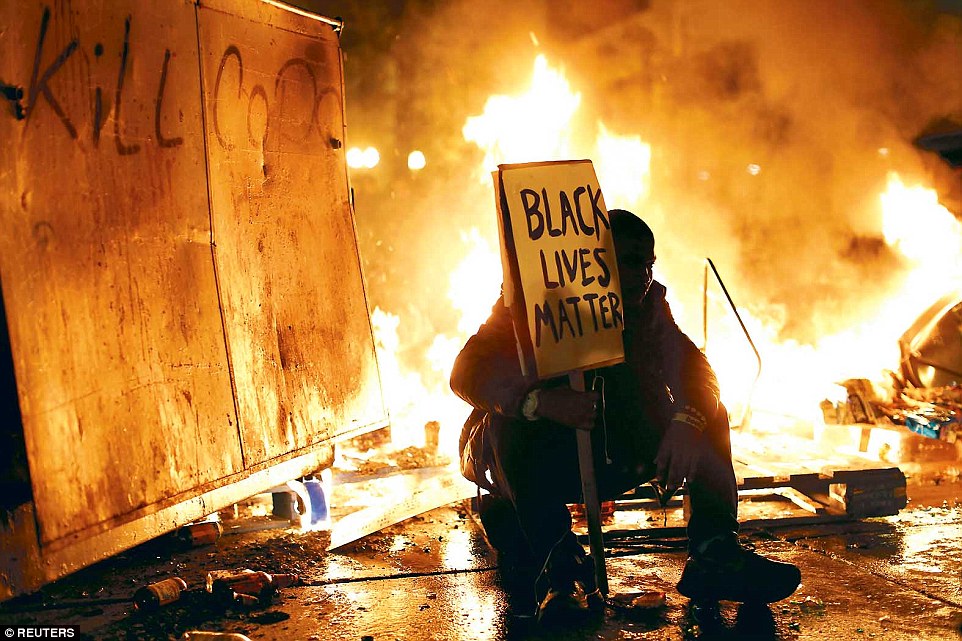
Obama could not resist weighing in on the event and sent his Attorney General Eric Holder, who arrived in Ferguson to comfort the Blacks, explaining that he himself as a Black experienced such racism and thus could feel their pain. Anyway, that was the proclaimed theme of Holder’s presence there. Holder also promised that the Department of Justice would conduct its own investigation into the matter, knowing of course that the local police would be required to do so as well – adding to the impression that typical police racism would most likely simply sweep the matter under the rug.
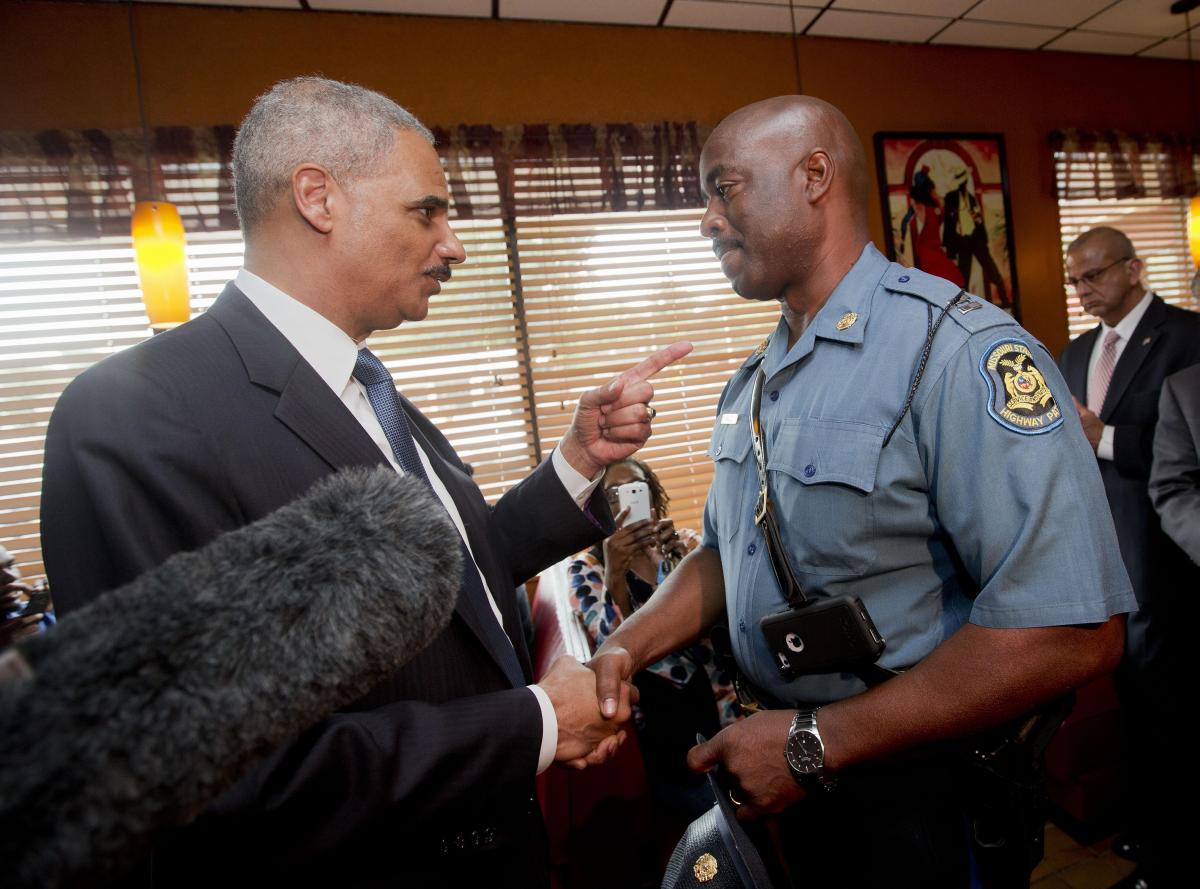
Holder making clear to the local police captain his own interest in the matter
But actual witnesses and forensic evidence eventually made it clear that Brown had assaulted Wilson − and had not surrendered and been shot with his hand up … as the “Hands up Don’t Shoot” T-shirts worn by angry Black protesters declared. Consequently, a grand jury found officer Wilson not guilty of any crime.
But this was not what angry Blacks were hoping for, and riots broke out again.

It would take another ten days for things to quiet down. In the meantime, Holder’s own investigation went forward. And he too finally had to agree with the judgement of the grand jury. But he was not happy about that − and ultimately presented a discourse to the press about the injustices of American society and the pain of America’s minorities. He felt that it was more important to stress the shame of America’s social divisions … than to guide the nation to a higher sense of racial unity.
Thus most sadly, over time race relations did not improve, but merely became more pronounced in their division. For instance, in August of 2016, San Francisco 49er quarterback Colin Kaepernick led a movement among his teammates to kneel in protest rather than stand in honoring America at the playing of the National Anthem.
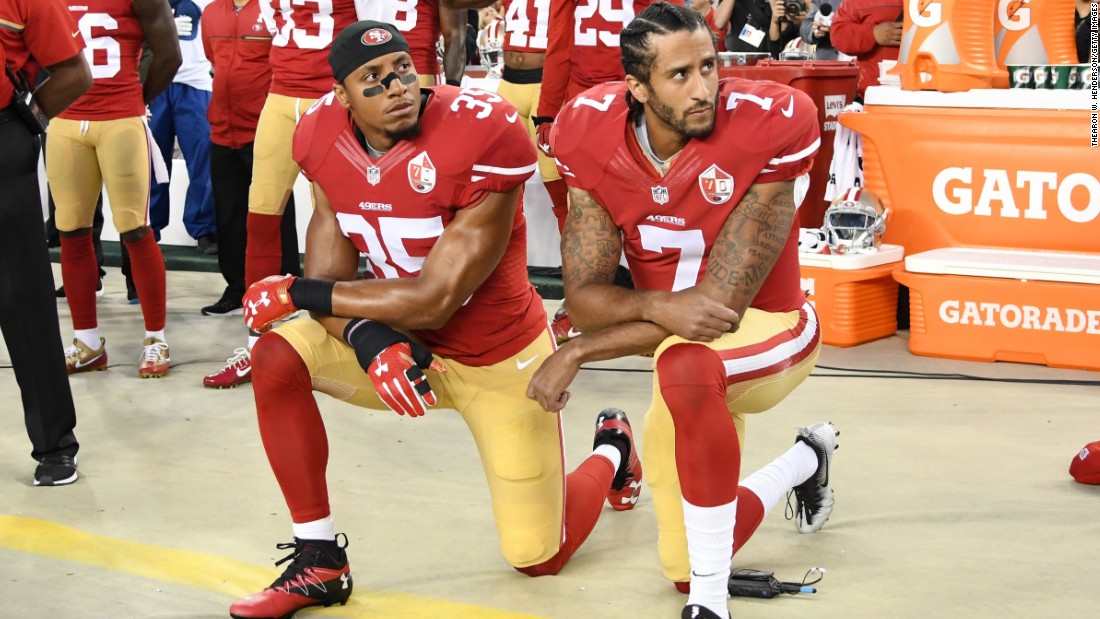
And this in turn inspired Obama to issue his own comments about how opposed he was to such evil … meaning White racism − not Black racism, the latter which he clearly supported. All this did was to stir racism in America − racism of any kind: Black racism in anger at White racism − but also White racism in anger at Black racism. And this would play big in the coming November 2016 election.
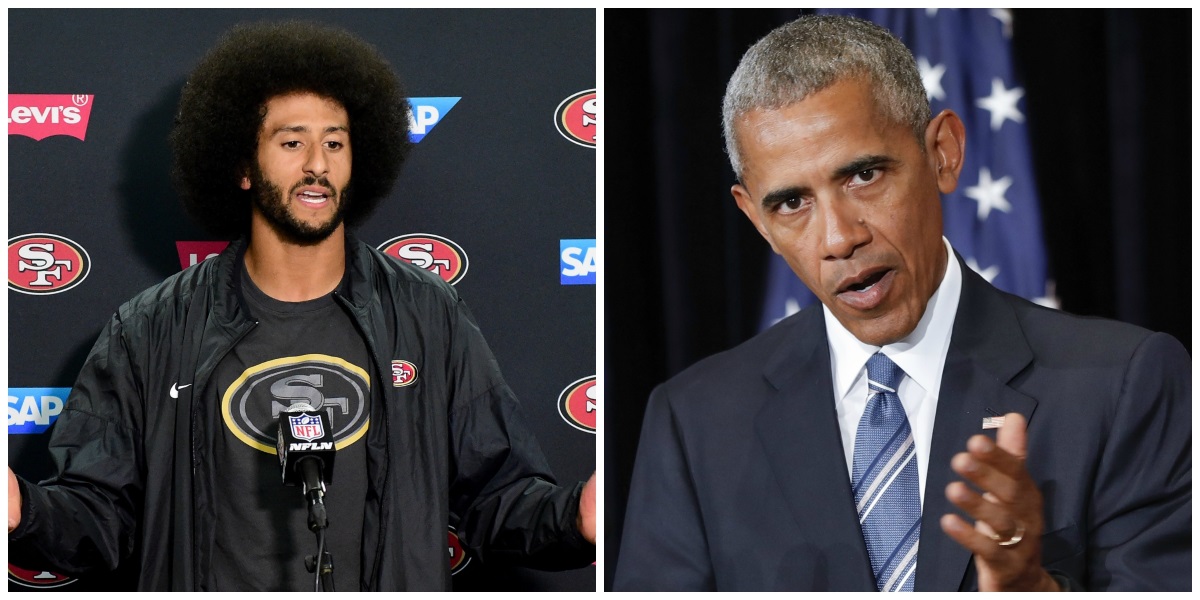
America’s foreign policy during the Obama years
Most unfortunately, as events would soon prove, foreign policy was not one of Obama’s strengths. He had little actual experience in the foreign policy realm, and instinctively approached matters as an Idealist rather than as a political Realist. Thus in many sad ways, under Obama the same “save the world for democracy” program that had directed the Bush Jr. Administration would continue during Obama’s years in office – with the same tragic results.
Iraq. The ongoing war in Iraq was Obama’s most immediate concern in the foreign policy arena. Ultimately Obama’s plan was simply to end military operations in Iraq by August of 2010, keeping a small number of American troops there only to train Iraqi troops. And these would be fully withdrawn by the end of 2011.
As far as the “democratic” purpose of the American involvement in Iraq, things in Iraq ultimately followed a pro-Shi’ite political schedule … despite Obama’s efforts to get some kind of Shi’ite-Sunni political compromise in place. At first something like that was promised. But with the full American withdrawal, things went back to “normal” in Iraq – with waves of violence repeatedly hitting the country, the one in 2013 particularly ugly. Eventually a more “moderate” Shi’ite came to power and relations improved with America and the West (involving the sale of $billions of American military equipment to Iraq) – and the larger Sunni Arab world as well.
Then in later years Iraq found itself looking more and more to Iran and Russia for serious support as problems developed with a new Islamic “caliphate,” which formed in 2014 through a union of Muslim Sunni fundamentalists in a region across both Syria and neighboring Iraq – and thus the Islamic State of Iraq and Syria (ISIS).

And ISIS was designed not only to end Western-styled Secularism (such as the Baathist Party represented) but also to bring down the enemy Shi’ite community (quite large in both Syria and Iraq). And that’s where things would stand in Iraq as of the end of the Obama Administration.
Afghanistan. However, with respect to the American war effort still going on also in Afghanistan, Obama was quick (February 2009) to announce that he would not be reducing, but instead increasing greatly (an additional 17,000), the number of American troops there – planning to achieve the same breakthrough there that Bush, Jr. had achieved with his “troop-surge” in Iraq. But this bold effort soon proved to have no impact, so Obama (in 2010) increased the number of troops by an additional 30,000. But strangely, at the same time he announced that he would also start the withdrawal of troops as of July 2011.
But what then was the purpose of all this? It left the American-supported government of Hamid Karzai in confusion as to its future status. And it simply emboldened the Taliban, not push it back.
Bin Laden finally taken down (May 2, 2011). At the same time, America’s long-standing excellent relations with Pakistan were quickly becoming quite negative – largely over this matter of Pakistan’s support of bin Laden’s al Qaeda organization, al Qaeda’s headquarters in fact located a short distance away from Pakistan’s Military Academy. But such knowledge, confirmed secretly, was finally what gave Obama the go-ahead to take down bin Laden – through a quick operation of an American Navy SEALS team. Bin Laden was thus killed on site, his body then dumped (with accompanying Muslim burial rites) into the Arabian Sea.
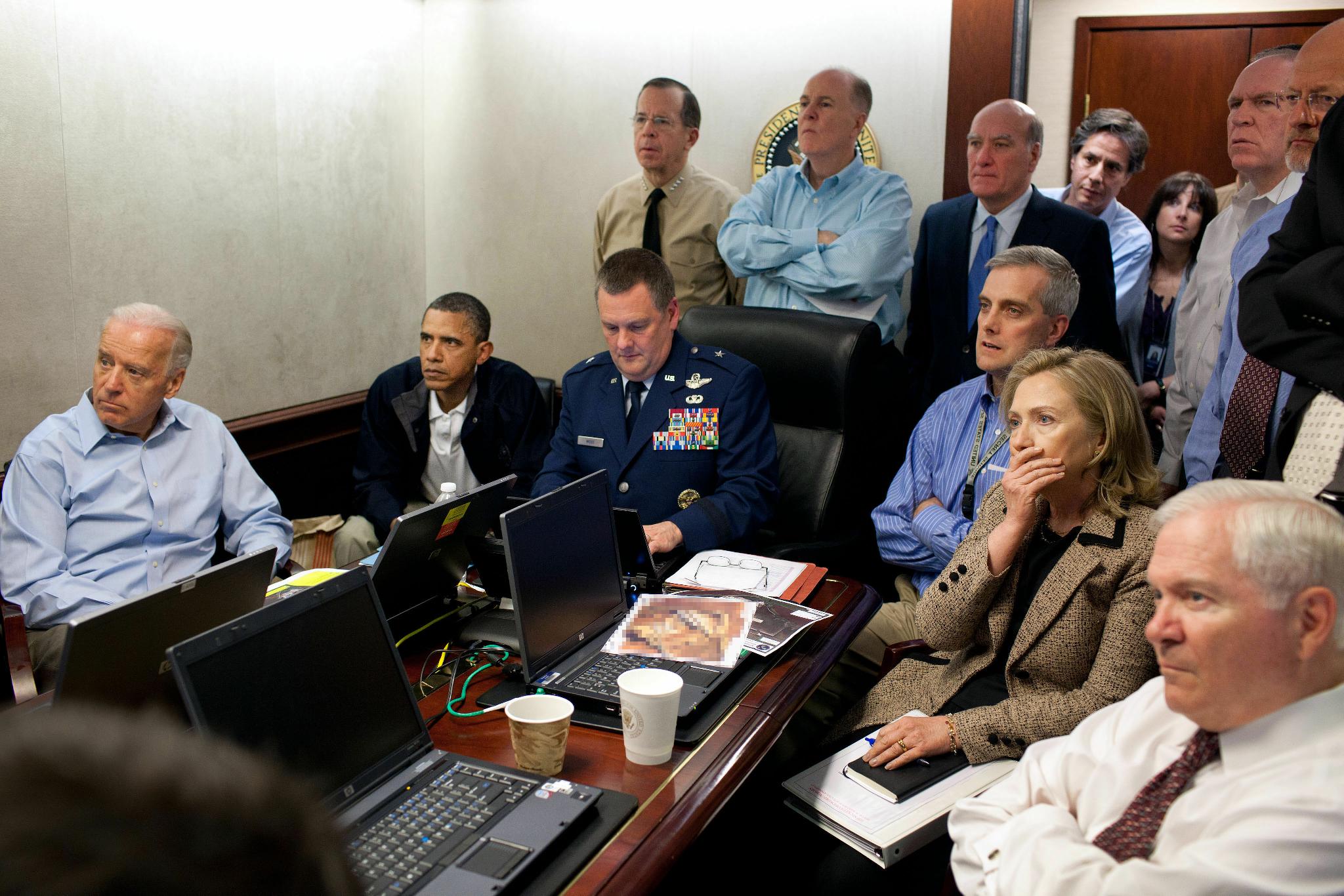
Americans rejoiced. The Pakistanis fumed. But there was nothing they could do about the matter. And for America, this finally left Americans able to move on from the 9/11 horror. But this also posed the question: was there any real need therefore to stay in Afghanistan at all at that point? Was there any way that Karzai could continue to govern from Kabul without American military support? Thus it was that there would be a troop reduction, but not an American withdrawal in Afghanistan (the same for the British, French, Belgian, Canadian, Spanish, Norwegian, etc. troops still operating there). But even then, remaining troops would continue to serve only as trainers and supporters of Afghan troops.
The catastrophic “Arab Spring” (early-mid 2011). A protest that started in December of 2010 over local matters (unemployment, inflation, poverty) in Tunisia quickly spun out of control, sending Tunisian autocrat ben Ali fleeing the country (January 2011), and ultimately offering Tunisia the chance to put in place a more democratic constitution – with the militant Islamists deeply disappointed in the October elections that year when Tunisian voters chose to stay on a more proto-Western political course.
But matters did not stop there … with the protest urge soon spreading to other Middle Eastern societies. Protests at first were simply in demand of reform, but soon turned into calls for the complete overthrow of the governments in power at the time. Hit particularly hard this way were Egypt, Syria and Libya – although all countries in the region registered something of the same dynamic.
And somehow Obama felt that it was up to him to ensure that the “democratic process” underway in those countries went in the right direction.
 Libya. With respect to Libya, the upheaval there was actually more of a civil war between two Libyan regions, the Western or Tripoli-based portion of the country largely supportive of Libyan dictator Muammar Gaddafi and the Eastern or Benghazi-based portion highly opposed to his rule − the latter led by a group that identified itself as the National Transition Council (NTC).
Libya. With respect to Libya, the upheaval there was actually more of a civil war between two Libyan regions, the Western or Tripoli-based portion of the country largely supportive of Libyan dictator Muammar Gaddafi and the Eastern or Benghazi-based portion highly opposed to his rule − the latter led by a group that identified itself as the National Transition Council (NTC).
Gaddafi had almost brought things back under his control across the country when Obama got the U.N. Security Council to pass a resolution enforcing “civil rights” in Libya … meaning, Gaddafi was to back off in his efforts to bring the country back under his control. At the same time, criminal charges were brought against Gaddafi in the International Criminal Court. Then the UN put in place a “no fly zone” over the country so that Gaddafi could not continue to protect his troops. Then France proceeded to airdrop weapons to the NTC – and NATO forces even began the bombing of Gaddafi’s forces.

Morally speaking, what gave Obama and his NATO (even UN) allies the right to determine Libya’s fate? Thankfully when Abraham Lincoln was doing the same thing that Gaddafi was doing, namely using brutal military power to end a civil war that had broken out in his country, no one at the time decided that they needed to intervene against Lincoln and his Union troops in order to protect “civil rights” in America. Rightly so, Lincoln is considered as one of America’s most important leaders because he did exactly what he did: force the country back into unity.
Of course, with NATO airpower support, the NTC was able to gain ground − in October that airpower even destroying a convoy trying to help Gaddafi escape into the desert, enabling NTC troops then to capture Gaddafi and execute him on the spot.
Then most tragically – and despite pleas the following year (2012) from Chris Stevens (America’s ambassador to Libya) for an upping of security at the embassy (in Benghazi itself) because the NTC was actually supporting rather than restraining radical groups in a broken-down Libyan social order – nothing was done by the Obama Administration.
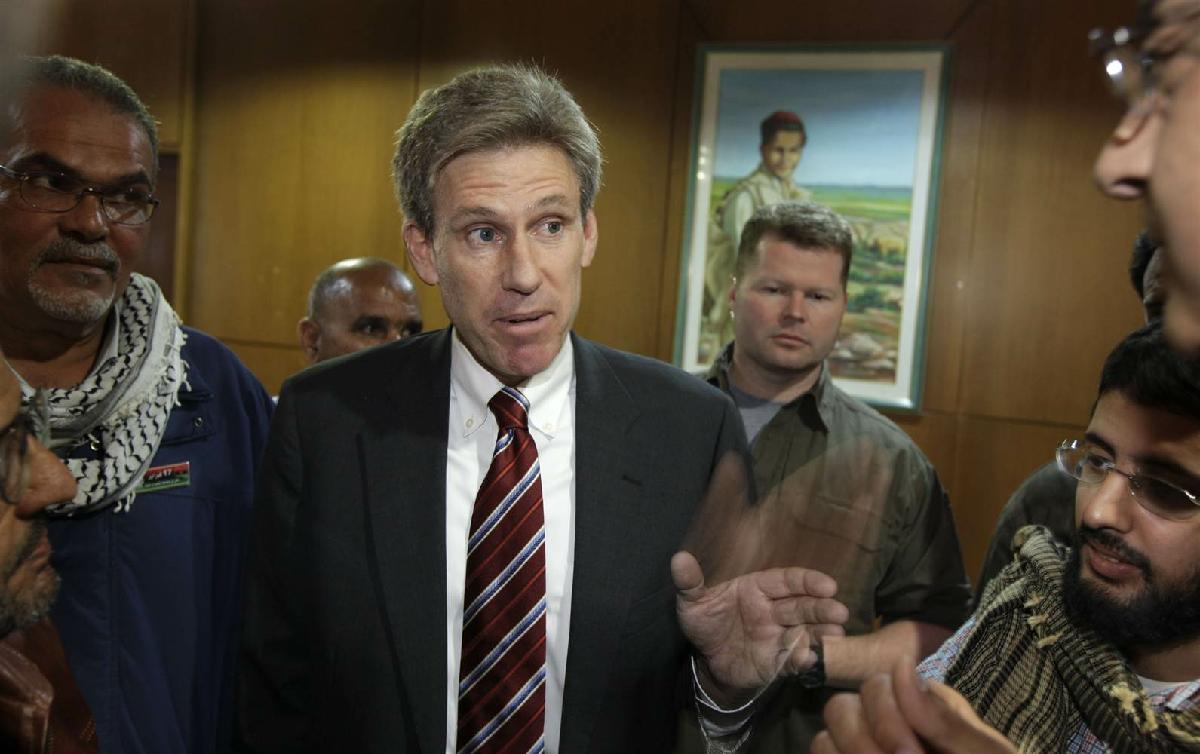
And in September of that year Muslim militants attacked and torched the American consulate and CIA annex, also killing Stevens and three other American officials in the process.
At first, Secretary of State Hillary Clinton claimed this was merely a passionate but spontaneous response to an anti-Muslim movie that had just come out.
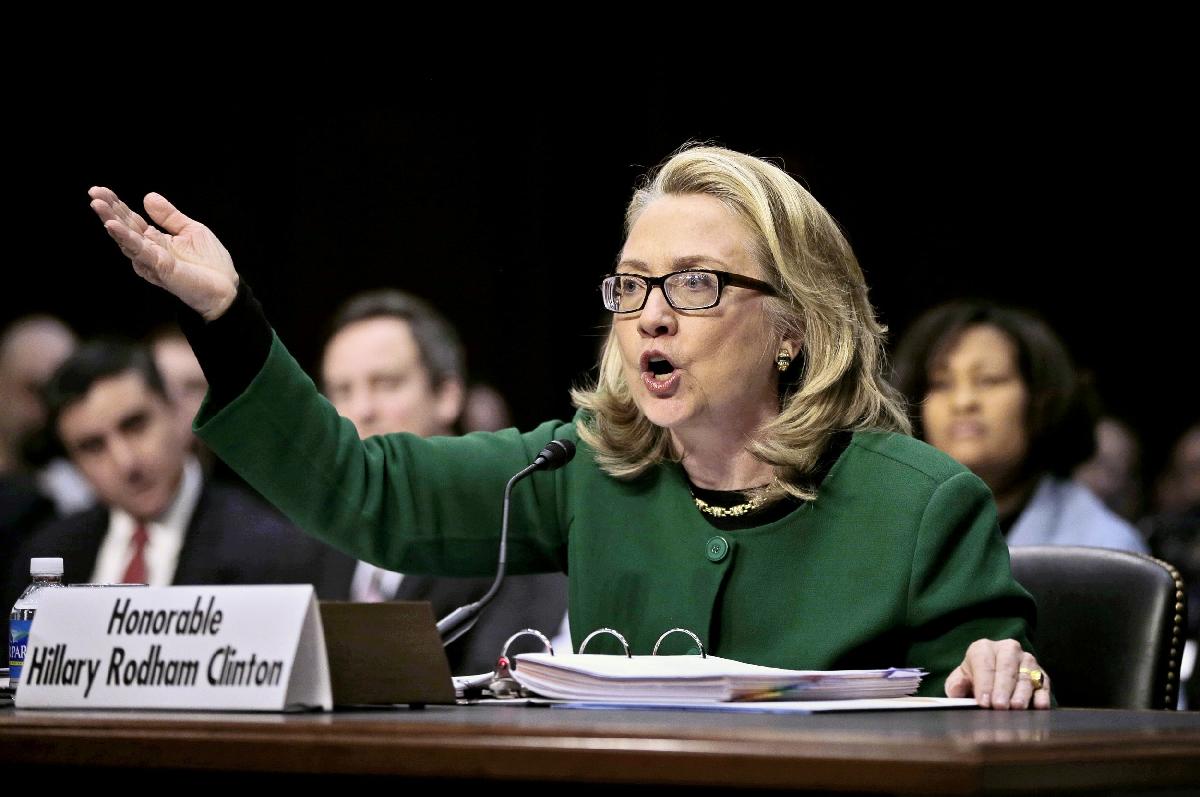
But the truth came out by December of that year that this had been a well-planned move, exactly the same that Stevens had warned about. Ultimately, the only response that was offered at this point by Obama was to put the blame on Hillary, and announce that he would soon (February) be replacing her as Secretary of State by John Kerry.
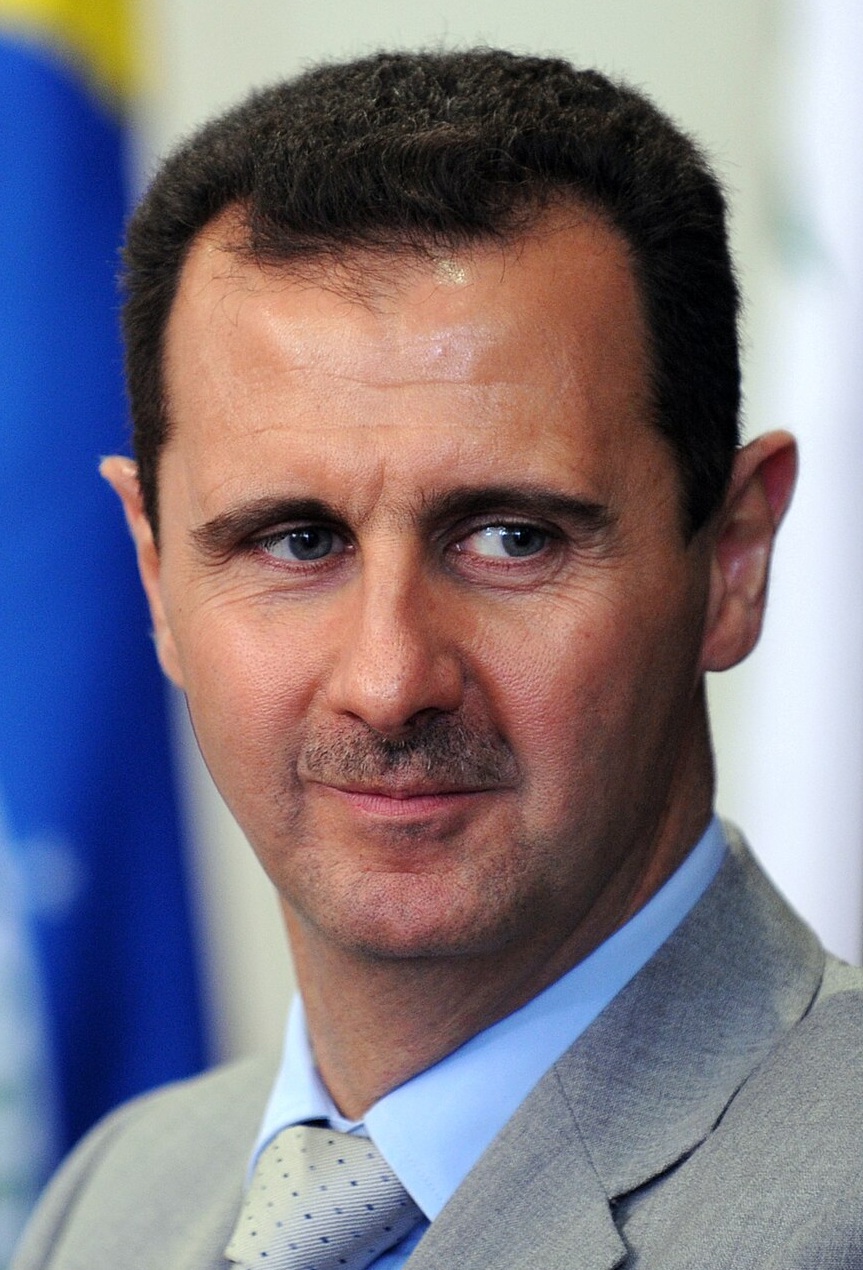 Syria. Things developed in Syria along lines very similar to the way things took shape in Libya. Here too, Assad’s efforts to bring order back to Syria were met with threats by Obama for Assad to back off because his behavior violated all standards of humane treatment of his people. Obama “drew a red line” stating that if Assad were in fact to cross that line in using certain types of weapons in his doings, he would have America to deal with.
Syria. Things developed in Syria along lines very similar to the way things took shape in Libya. Here too, Assad’s efforts to bring order back to Syria were met with threats by Obama for Assad to back off because his behavior violated all standards of humane treatment of his people. Obama “drew a red line” stating that if Assad were in fact to cross that line in using certain types of weapons in his doings, he would have America to deal with.
But Assad was too busy trying to restore order to pay Obama much attention. And thus the “red line” proved to be merely an empty threat – when Assad pushed ahead and Obama did nothing.
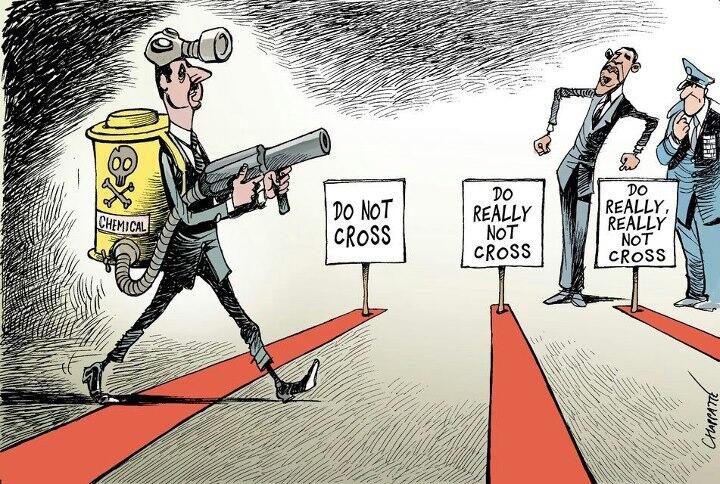
Anyway, at this point, numerous countries were now getting involved, supporting this group or that group in Syria’s multi-ethnic society. America, in concert with Saudi Arabia, now even began to ship arms to Assad’s opponents – basically Muslim fundamentalist groups.
Then Putin agreed to step in, to “mediate” between Obama and Assad – all of that simply turning into an opportunity for Putin to move into Syria as a political ally. Indeed, this move set Russia up nicely with a position of support on the Mediterranean coast, something long dreamed of by Russia. And America was now out of favor in this same region diplomatically and politically – as long as Assad stayed in power, which – now with Russian support – was likely to be for a very long time.
But for the Syrians themselves, civil war continued as various groups managed to entrench themselves in different parts of the country, and attack others not wanted in those particular regions. Ultimately, the biggest organization to come to life from this chaos was ISIS … which Assad was not able to bring under control.
Thus the civil war deepened, sending millions of Syrians to escape Syria – most of them finding their way to dismal refugee camps in Lebanon, Jordan, Turkey and Iraq … but many making their way to Greece, Italy and even Germany. It is estimated that by early 2018, some 5½ million Syrians had fled their country, with another five million still living deeply dislocated lives within Syria.

And sadly, America no longer played the role of the superpower referee as it had in the 1980s and 1990s, but instead merely that of a dangerous meddler, whose involvement had served only (as in Libya) to make things worse – much, much worse – for the Syrians.

A Syrian refugee camp in Jordan. By 2015 fully 25% of the population of Lebanon was made up of Syrian refugees and similarly 20% of the Jordanian population.
Egypt. In Egypt this event took the form of a major and ongoing demonstration by protesters encamped in Cairo’s Tahrir Square. They wanted Egypt’s longtime (almost 30 years) government of Hosni Mubarak brought down. Finally the Egyptian military intervened and arrested Mubarak … which however did not end the Tahrir Square protests. Finally, in the midst of ever-worsening violence, elections for a new Egyptian Assembly were held in November − and then the final round of presidential elections the following June. Those elections resulted in a narrow victory (51.7 percent) for Mohamed Morsi, backed strongly by the Muslim Brotherhood, and loss (48.3 percent) for the secular candidate, Ahmed Shafik.
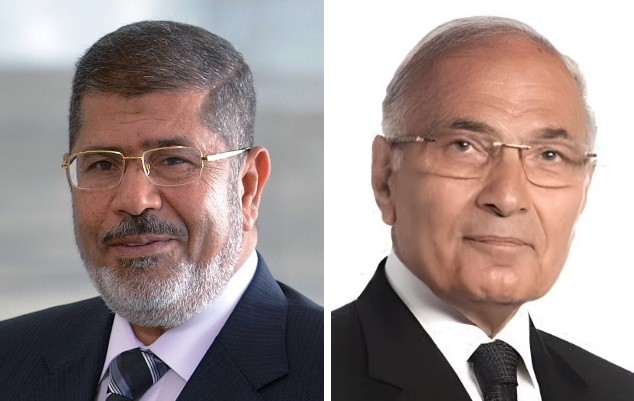
Morsi Shafik
Obama’s only involvement in all this was to offer his congratulations to Morsi, affirming that America would be willing to work closely with him – a strange idea, as it was the Muslim Brotherhood that had stood behind the 9/11 attack on America only a decade earlier. Was he being serious – or was he just being “nice”?
Morsi’s opponent Shafik knew immediately what his electoral loss meant, and left Egypt – just prior to a warrant for his arrest being issued by Morsi! No surprise there. And most unexpectedly, none of this cleared the protests, which simply continued at Tahrir Square – the protests now expanding dramatically in number and extent. By the next spring (2013) protesters were able to present a petition with 22 million signatures calling for a new round of elections (there had been many serious questions about the conduct of the earlier election). Morsi was unmoved – even as Egypt grew more chaotic.

An anti-Morsi protest in Cairo – June 2013
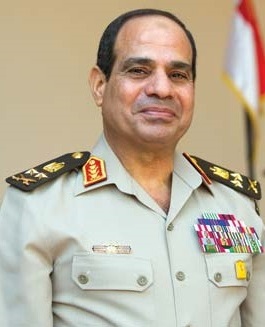 Finally the military under General Abdel Fattah El-Sisi stepped in and took control. Egypt settled down. Then the following year (2014) elections were held again – with the Muslim Brotherhood boycotting the election … and with General Sisi therefore gaining nearly all the votes.
Finally the military under General Abdel Fattah El-Sisi stepped in and took control. Egypt settled down. Then the following year (2014) elections were held again – with the Muslim Brotherhood boycotting the election … and with General Sisi therefore gaining nearly all the votes.
Obama was very upset over this termination of “democracy” in Egypt, and made the decision to cease further sales of military items to Egypt (such as the F-16 fighter jets).
Sadly Obama failed to understand how American-style “democracy” had no likelihood of ever developing in Egypt (or many other places in the world) – such democracy highly dependent upon there being particular social-cultural foundations well-built into the thinking and political habits of the people. In Egypt, such cultural-political foundations were deeply split (as they were also in Syria, Libya and elsewhere in the Middle East) between fierce defenders of Muslim traditionalism and equally fierce defenders of modern Secularism on the Western model. It was going to be one or the other. And it was not up to America to decide the matter for the Egyptians. And it certainly made no sense for America to be supporting a political group dedicated to bringing down everything that America stood for.
Iran. As we have seen, with the fall of the Shah in 1979, Iran had moved strongly in the direction of Muslim Fundamentalism … unknown thousands being killed in the process. But gradually, in the 1990s and early 2000s, it had softened up its anti-West stance somewhat. But in 2005, under a new president, Mahmoud Ahmadinejad, it swung back into its anti-West, anti-American attitude. Then when elections came around in 2009, Ahmadinejad won reelection in a highly questionable voting process (14 million ballots missing) − and with huge anti-Ahmadinejad protests shaking the country. But Ahmadinejad merely dug into power more tightly.
At that point his anti-American attitude also hardened further. And there was speculation that his nuclear research “for energy purposes only” (strange in a huge oil-producing country) was in fact for possible weapons use. And his pushing for the development of a missile program increased suspicions about his actual intent in all this. Obama even then took a very strong position at the UN to block Iran’s nuclear development. But Asia (including China), Africa and Latin America stood strongly in support of Ahmadinejad.
Then in 2013, new president Hassan Rouhani (re-elected in 2017) indicated that he wanted to improve relations with America and the West. Thus Obama became a strong supporter of the negotiations being conducted with Iran by America, Britain, France, China, Russia, and Germany over Iran’s nuclear development program. In 2015 a Joint Comprehensive Plan of Action (JCPOA) was announced, allowing carefully restricted nuclear development to take place in Iran, starting at the beginning of 2016.
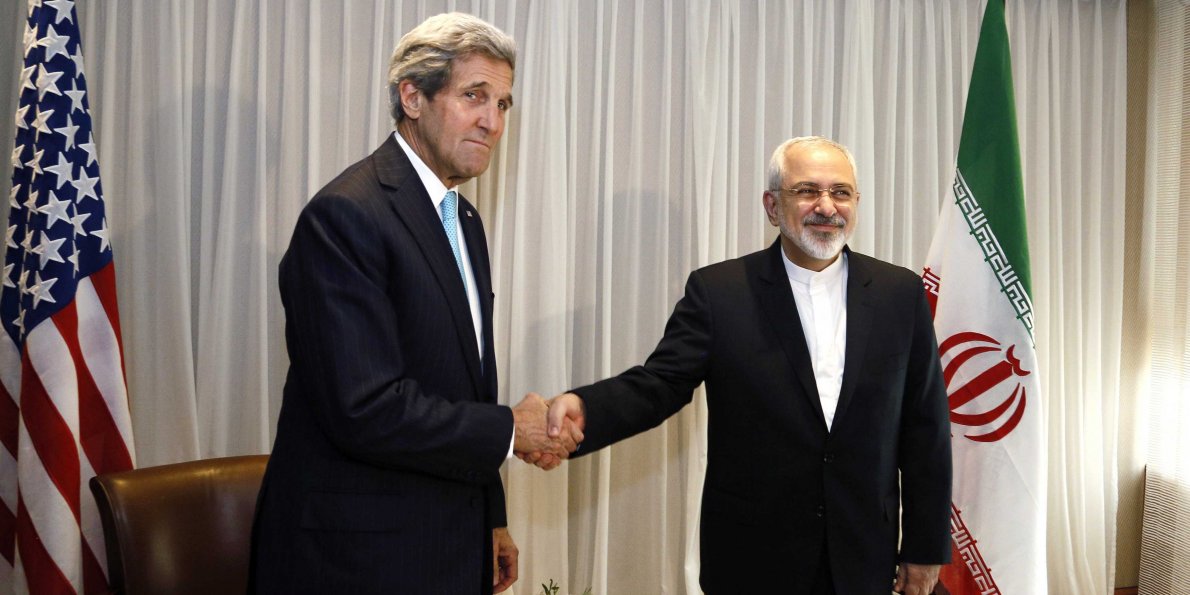
U.S. Secretary of State Kerry and Iranian Foreign Minister Zarif – Geneva, January 2015
Naturally there were those who felt that it was too easy for Iran to withdraw from the Plan when it no longer suited Iranian interests – a huge likelihood if Iranian Muslim Fundamentalists were to come to power again in Iran. But for the time being, it was played as a great diplomatic achievement for the Obama Administration.
Russia. Early on in his administration, Obama sought to “restart” relations with the Russians … by lowering the American military profile in Europe − namely by ending plans to put a missile shield in Poland and radar intercepts in the Czech Republic. Obama answered shocked Europeans with the promise that they would be better protected by American ship-based interceptors, hopefully fully deployed by 2018. The only people that found themselves pleased by this move were the Russians … and members of his Democratic Party.
Then with the outbreak of the Arab Spring in 2011, a treaty under lengthy negotiation cutting back strategic arms on both American and Russian sides was finally approved in Congress − pushed by Obama’s hope to enlist Russian support for his “democratic” program in the Middle East, most notably Syria.
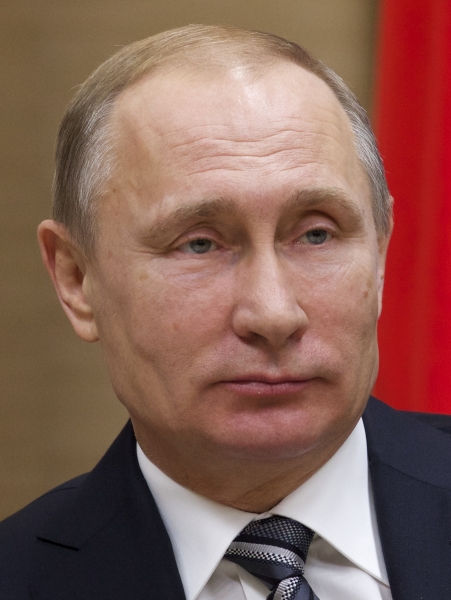 At this point, Russian president Vladimir Putin figured he had summed up Obama pretty well … and in 2014 began to make moves to seize territory that both Russia and Ukraine had agreed to share − namely the strategic naval base in the Crimean Peninsula. Obama, aware of Putin’s intentions, made a 90-minute phone call to Putin, urging him not to make the move … or “serious consequences” would result.
At this point, Russian president Vladimir Putin figured he had summed up Obama pretty well … and in 2014 began to make moves to seize territory that both Russia and Ukraine had agreed to share − namely the strategic naval base in the Crimean Peninsula. Obama, aware of Putin’s intentions, made a 90-minute phone call to Putin, urging him not to make the move … or “serious consequences” would result.
But Obama’s actions in Syria made very clear what Obama’s serious consequences would likely turn out to be. And thus when Putin sent Russian troops into Crimea to grab the naval base, Obama did nothing.
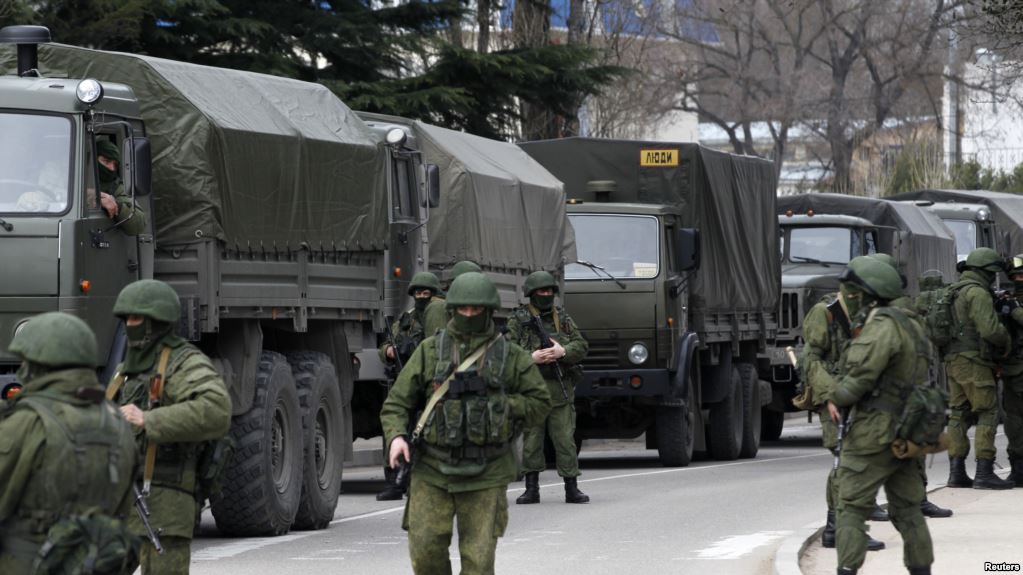
Unmarked and masked Russian troops about to invade Ukraine – March 2014
So much for “serious consequences.” Ultimately Obama did get the Europeans to take action against Russia, by lowering their purchase of Russian oil and gas … which of course worked nicely for American exporters of the same items! And that pretty much summed up Russian-American relations during the Obama years.
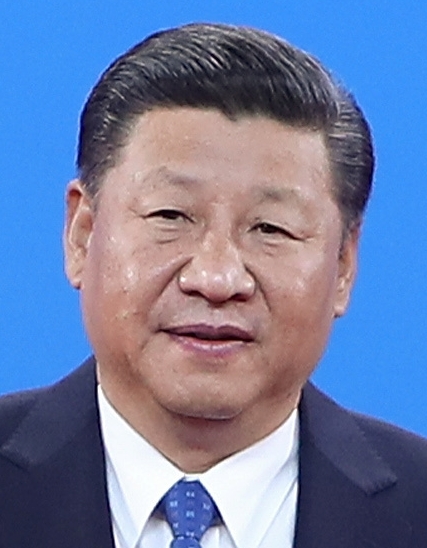 China. Meanwhile, China’s paramount leader (head of the Communist Party since 2012 and Chinese president since 2013), Xi Jinping busied himself during the Obama years in turning China back to its more traditional form of dictatorial rule, having China confirm a new constitution in 2018 which made him eligible to run continuously for the presidency. He even instituted his own “cult of personality” in the form of Xi Jinping Thought. And he pushed ahead the effort to make China more purely “Chinese,” by finding cruel ways to reduce the non-Chinese (Turkic) Uyghur population living in the Northwest region of Xinjiang.
China. Meanwhile, China’s paramount leader (head of the Communist Party since 2012 and Chinese president since 2013), Xi Jinping busied himself during the Obama years in turning China back to its more traditional form of dictatorial rule, having China confirm a new constitution in 2018 which made him eligible to run continuously for the presidency. He even instituted his own “cult of personality” in the form of Xi Jinping Thought. And he pushed ahead the effort to make China more purely “Chinese,” by finding cruel ways to reduce the non-Chinese (Turkic) Uyghur population living in the Northwest region of Xinjiang.
But most importantly, Xi moved strongly to make China a very much more aggressive player in the international game … with the clear intent of replacing America as the world’s sole superpower. He strengthened state support of China’s high-tech industries – and other areas of China’s vast industrial export domain. He worked hard to bring others economies of the world under Chinese commercial influence … through his Belt and Road Initiative started up in 2013, involving special trade relations with Third World countries (and any countries for that matter) that were anxious to receive Chinese economic support and development. And he worked hard to strengthen further a monetary union among Brazil, Russia, India, China and South Africa (BRICS) – designed to offer the world a financial system operating in opposition to the dollar. With respect to all this, there was very little that Obama could do to counter these strong Xi moves.
But Obama should have done something to support America’s East Asian allies when Xi decided that the South China Sea was not high seas but in fact Chinese territory. In doing this, he put the economies of numerous other countries bordering the South China Sea (Philippines, Vietnam, and Malaysia principally) – or requiring passage through that area to reach the larger world (Japan, Korea, and Taiwan) under strong Chinese pressure. Finally, to enforce this right (he got nowhere with the U.N. on the matter), in December of 2013 the Chinese began the process of dredging the shallow waters of the Spratly Islands − in order to build artificial islands on various coral reefs located there. In a trip to Washington in September of 2015 (with the operation nearly completed) Xi promised Obama that he had no plans to “militarize” those islands.
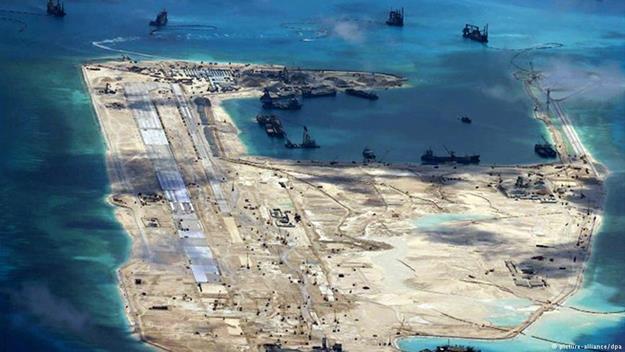
But the building of air strips on three of these islands should have raised strong suspicions on Obama’s part. Indeed, very soon surface to air missiles and fighter jets were deployed to those islands.
Why didn’t Obama take some kind of countering move – to protect the rights of America’s Asian friends? Why didn’t Obama do some dredging and island-building of America’s own – say 50 miles north of the Chinese island group? But to do nothing at all? This was a very big matter. But doing nothing was not uncharacteristic of the Obama foreign policy program.

Go on to the next section:
America’s Divisions Deepen